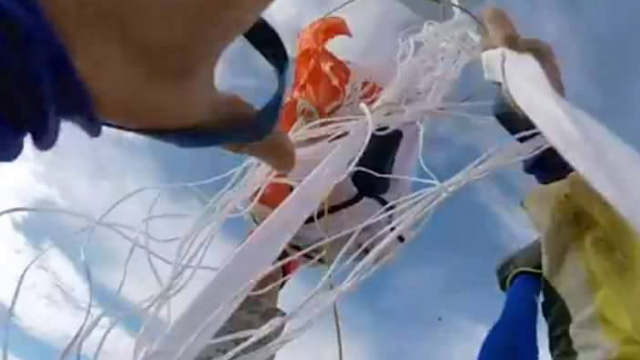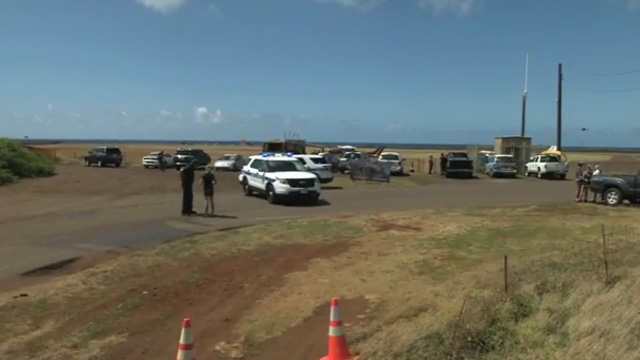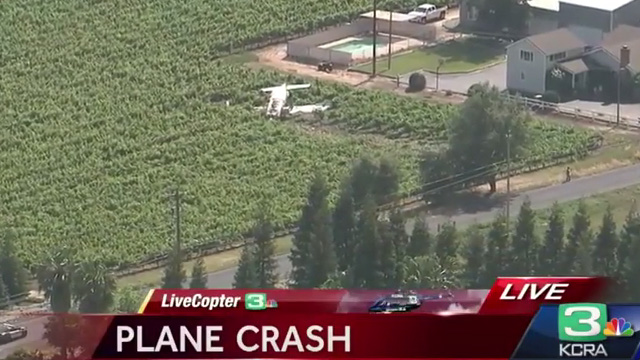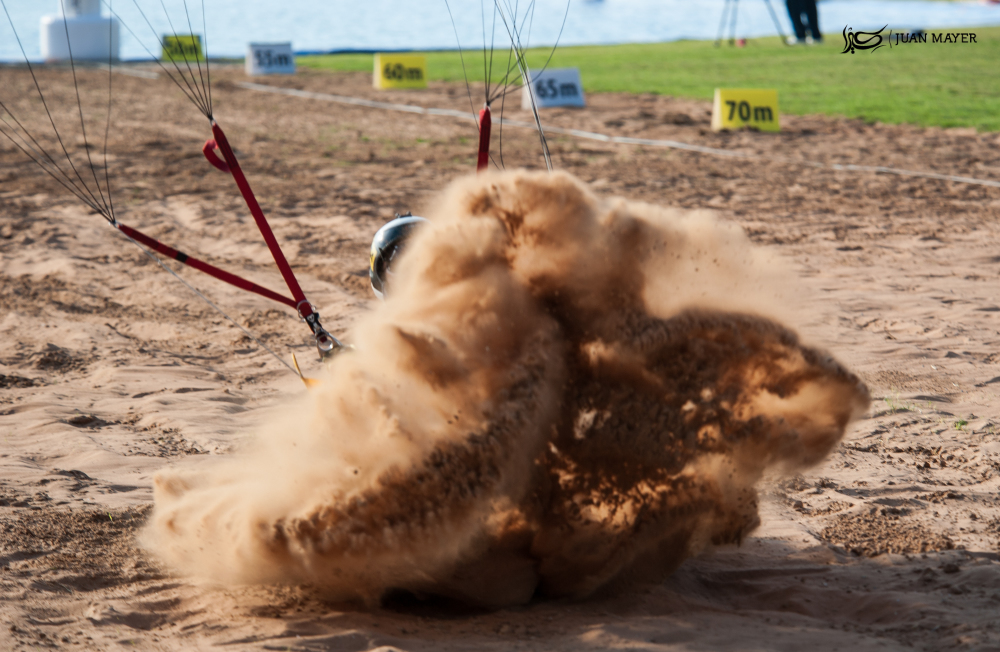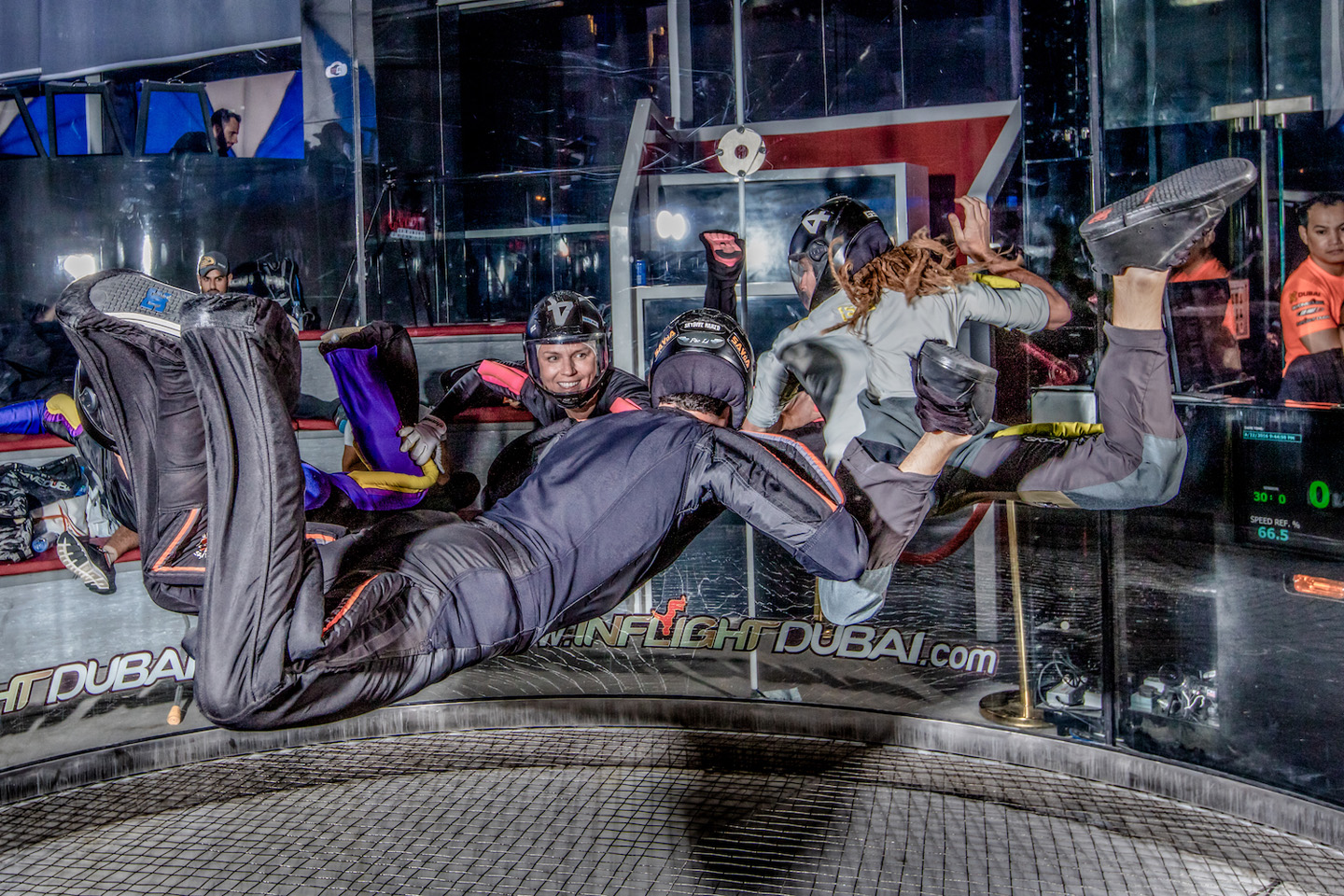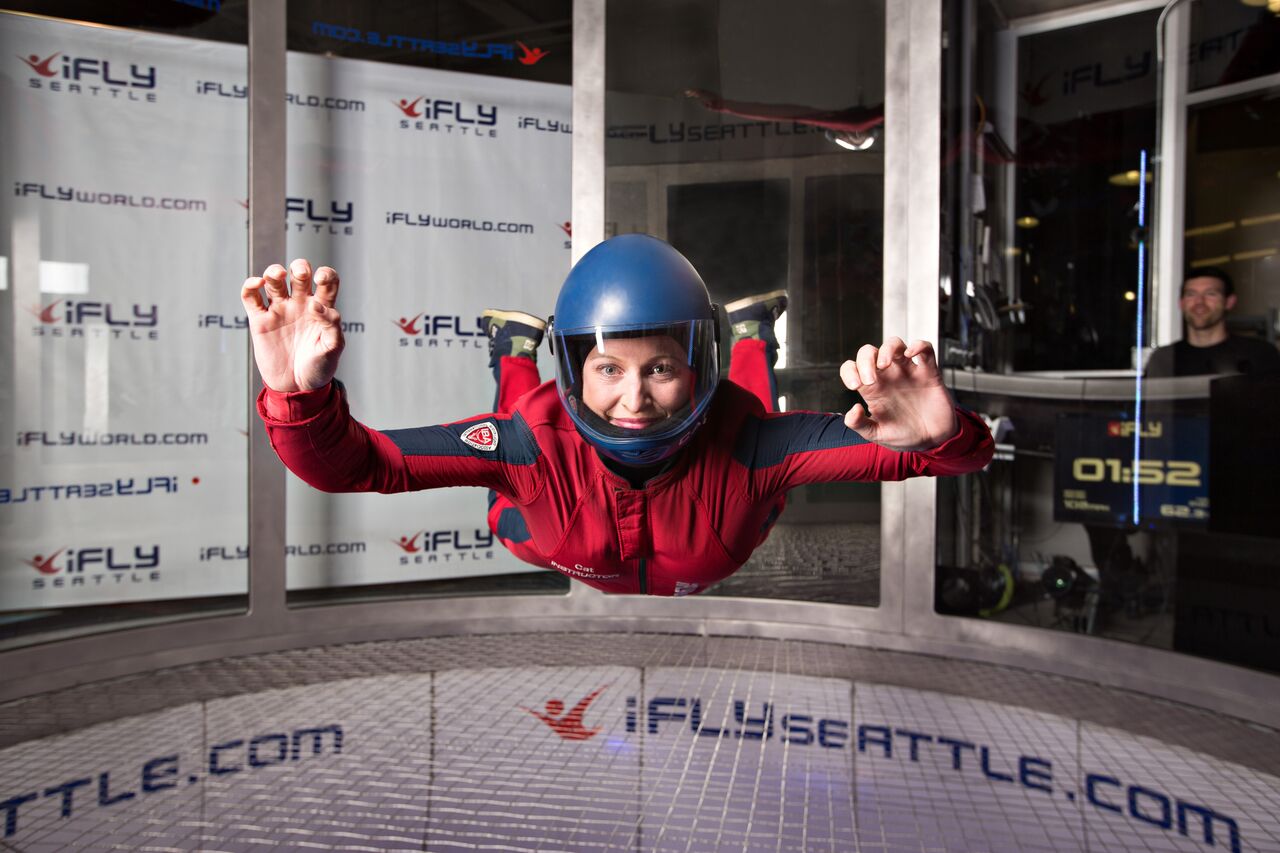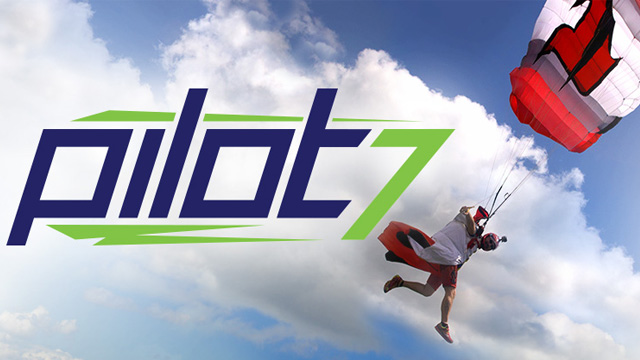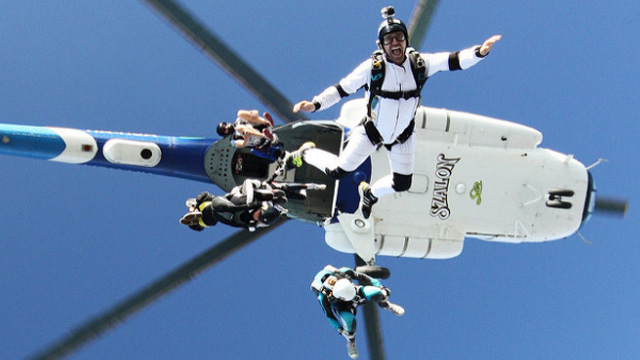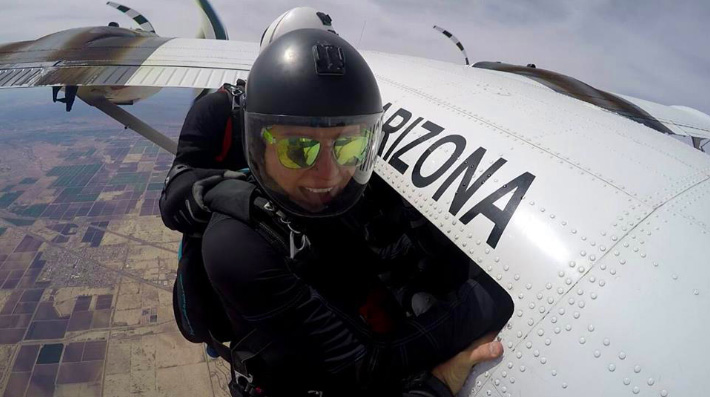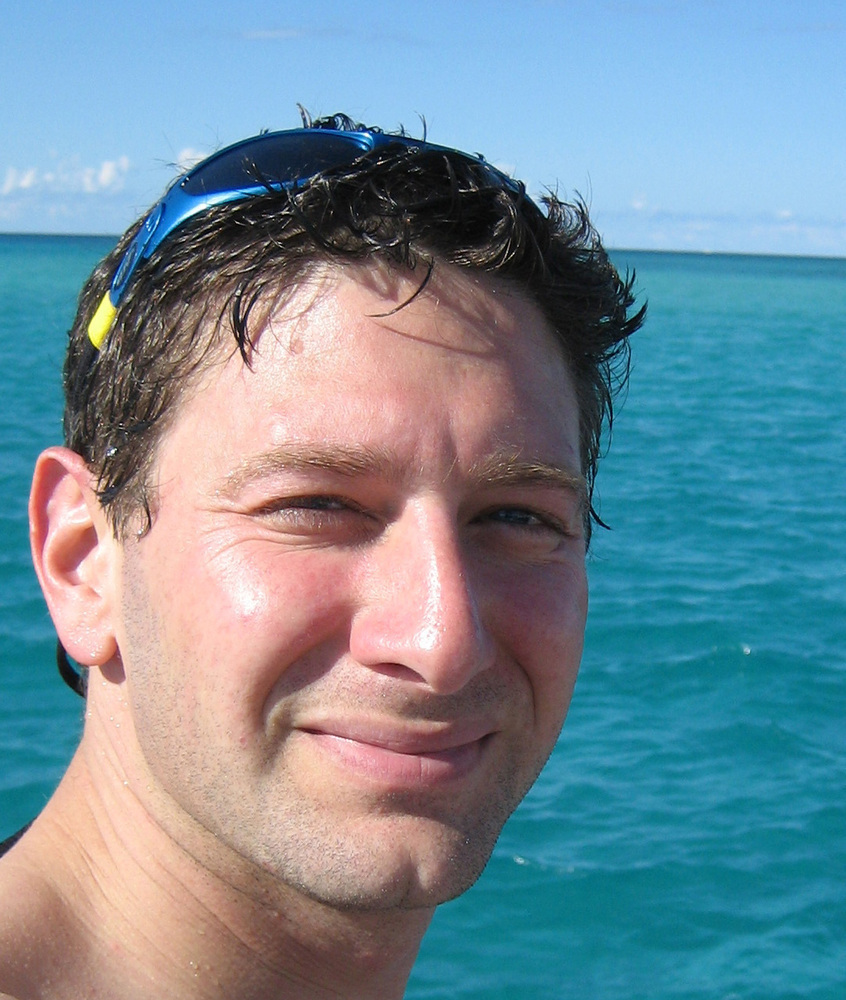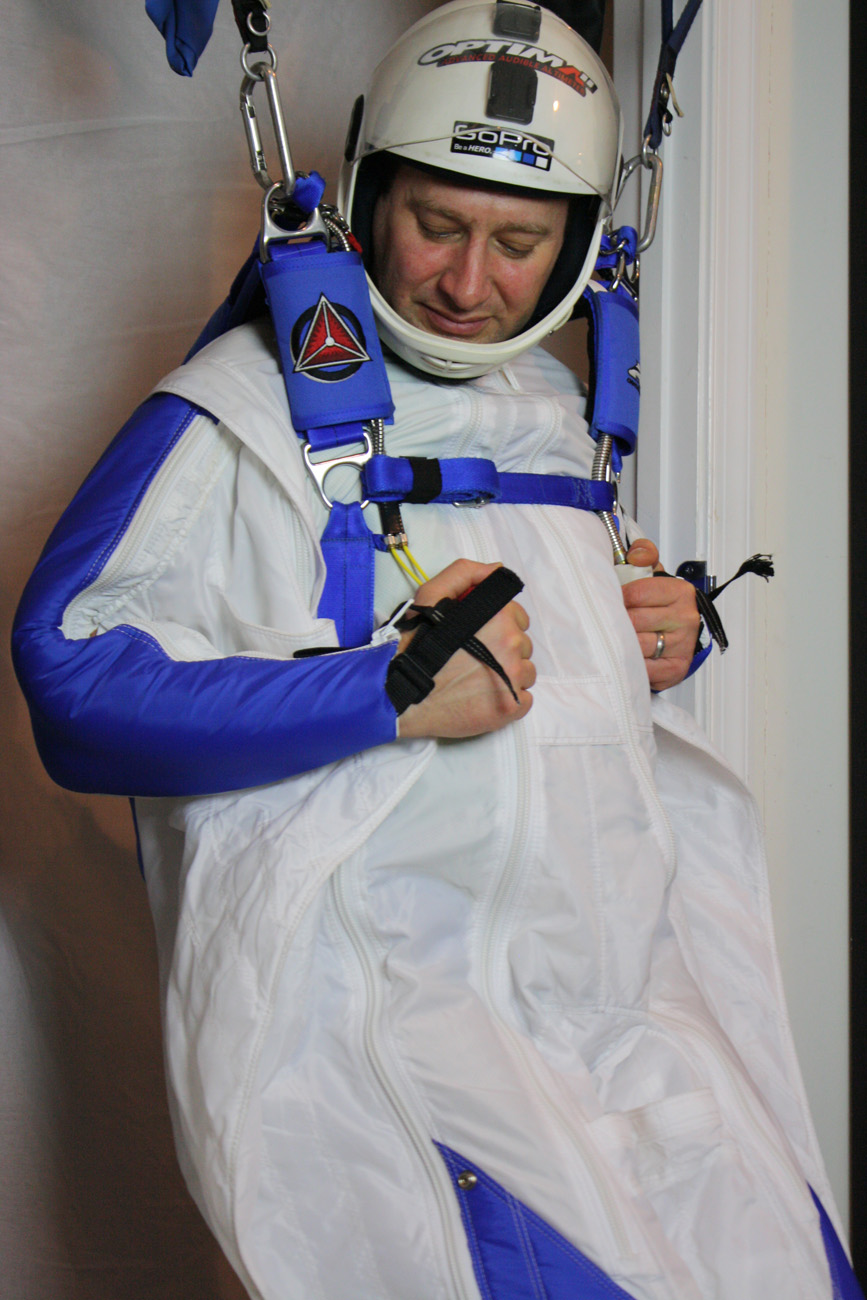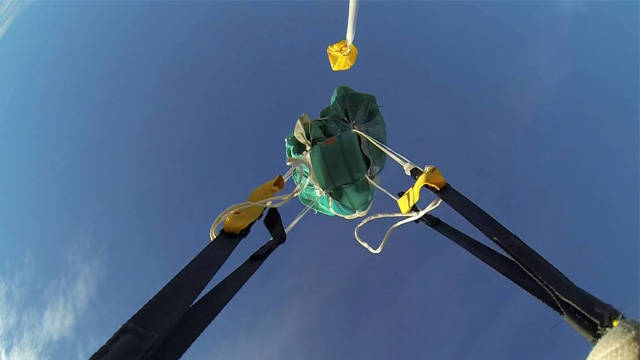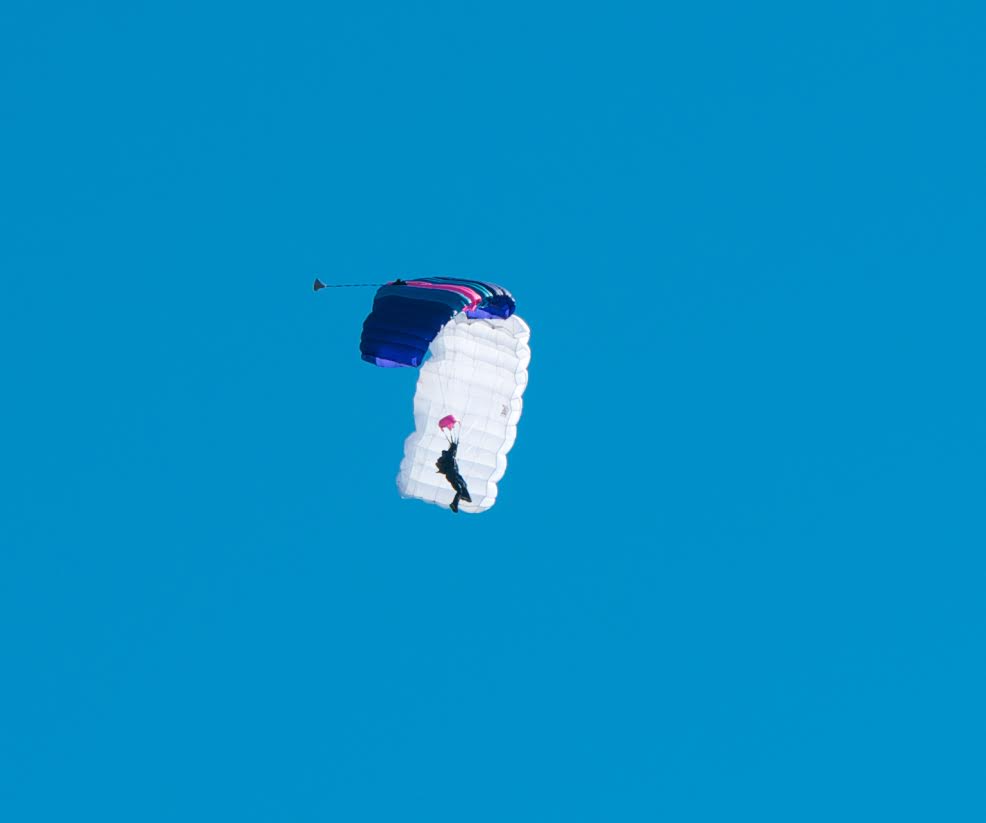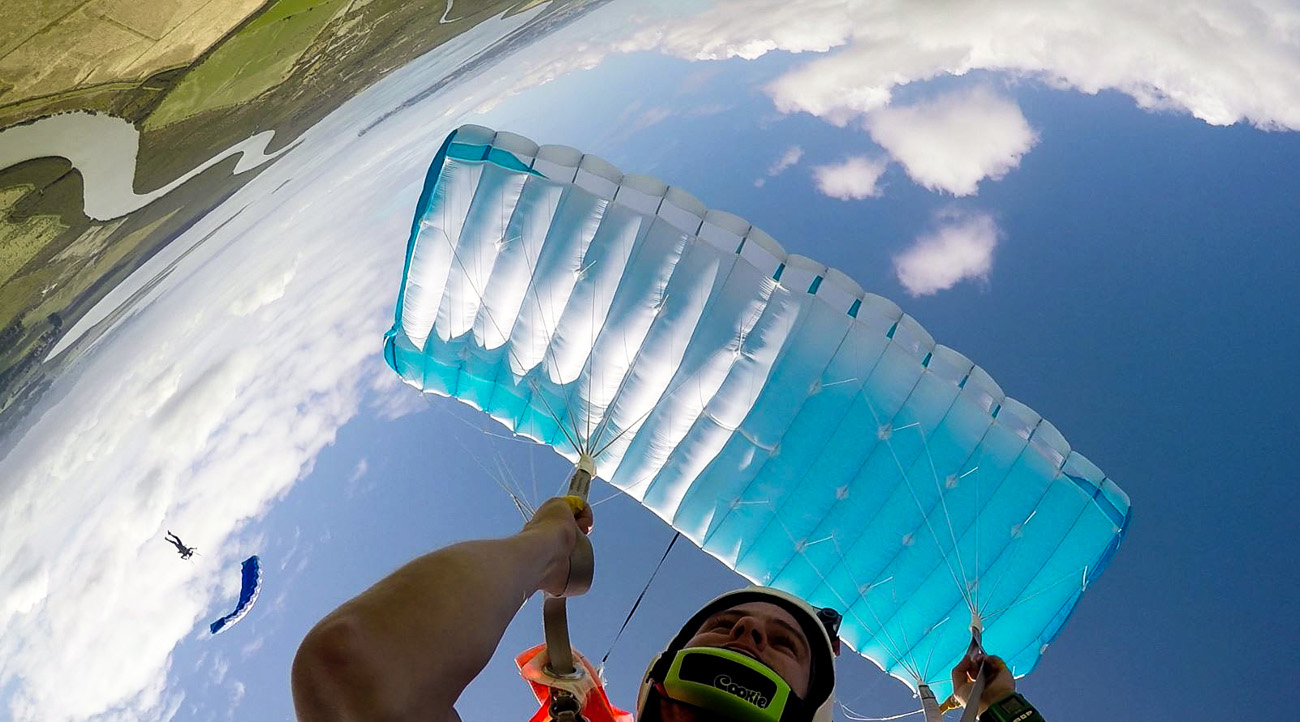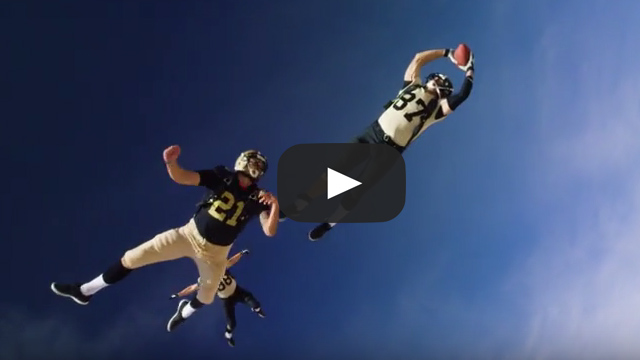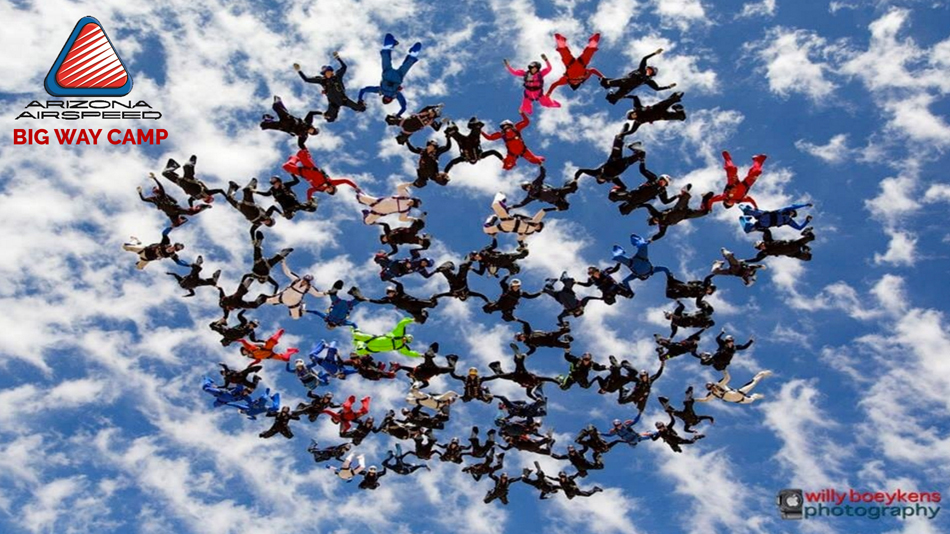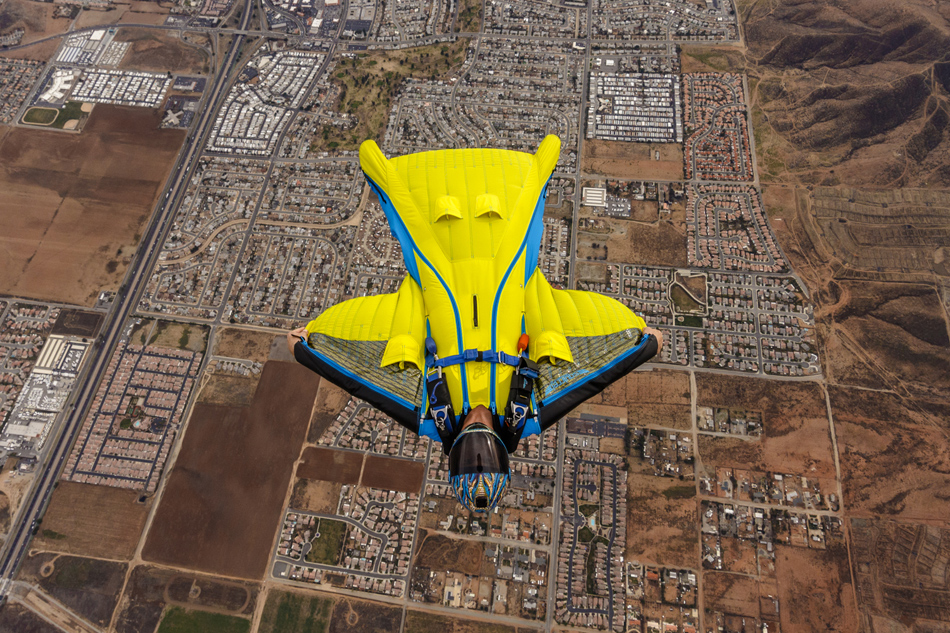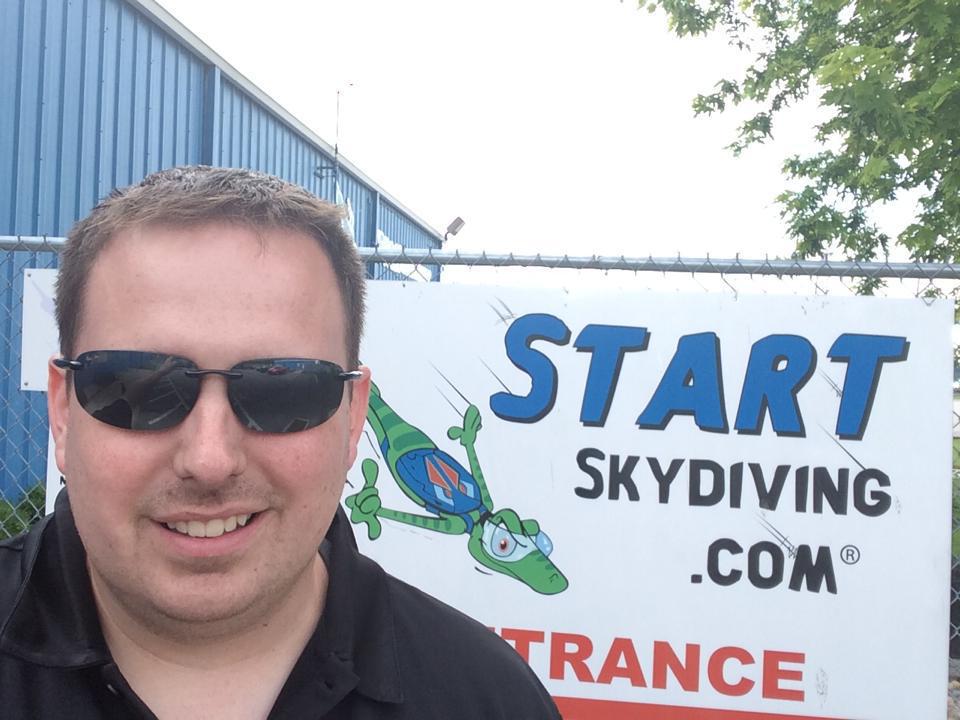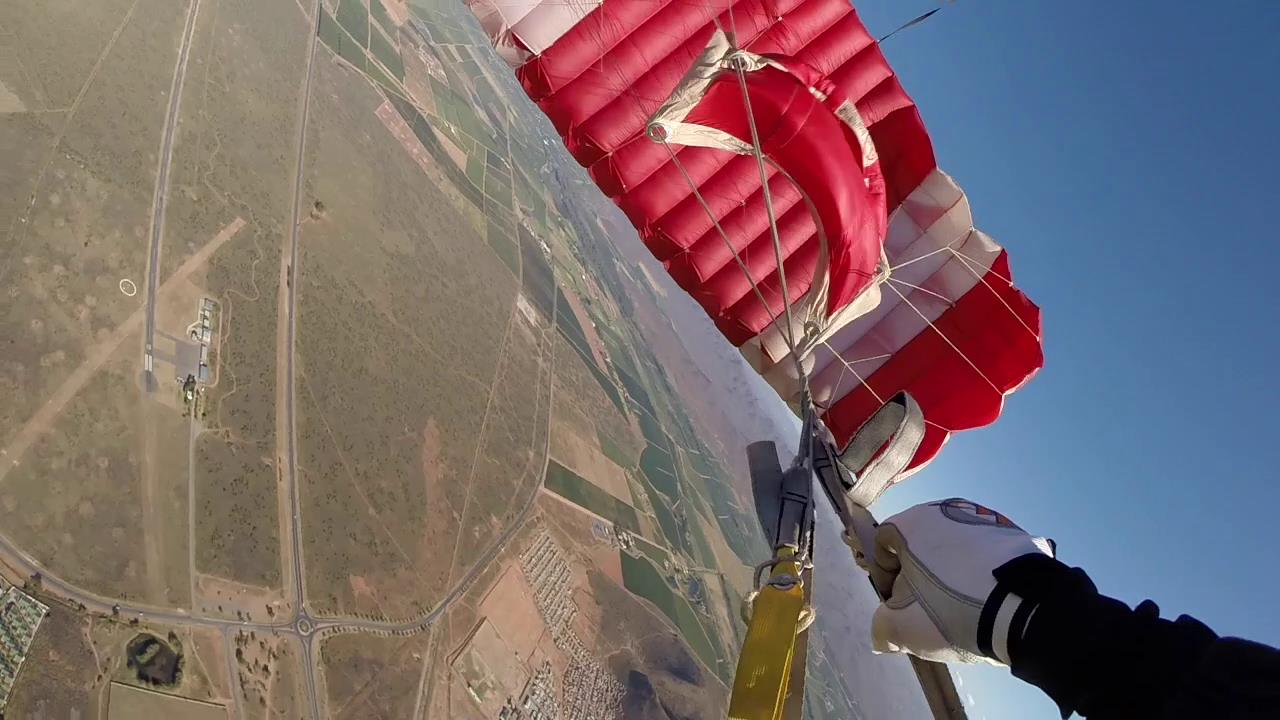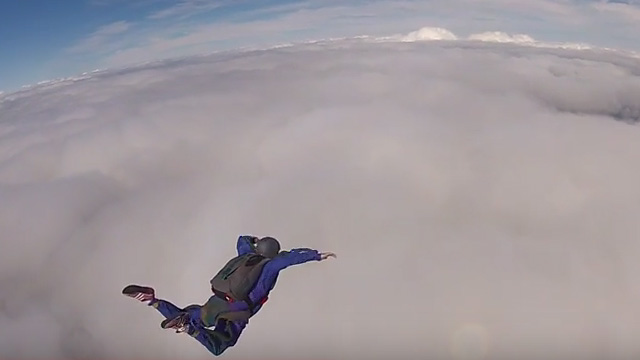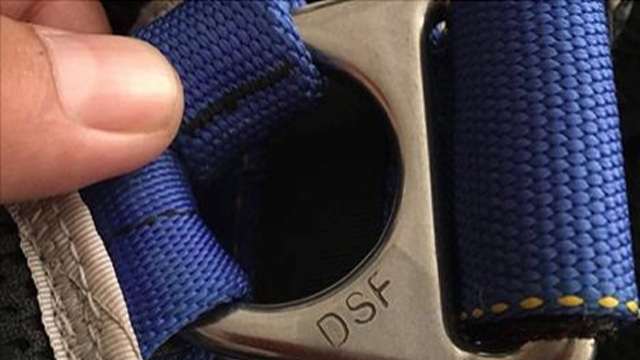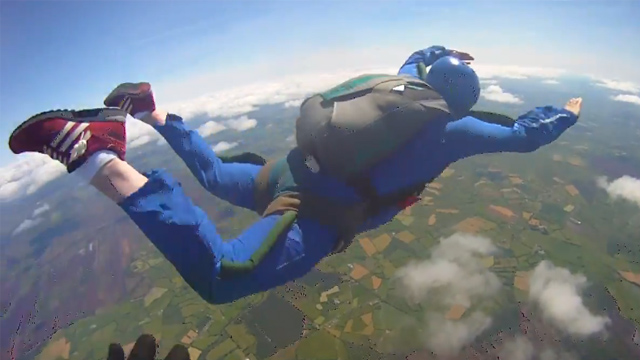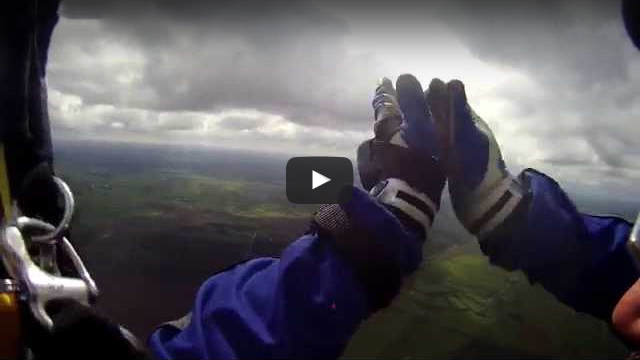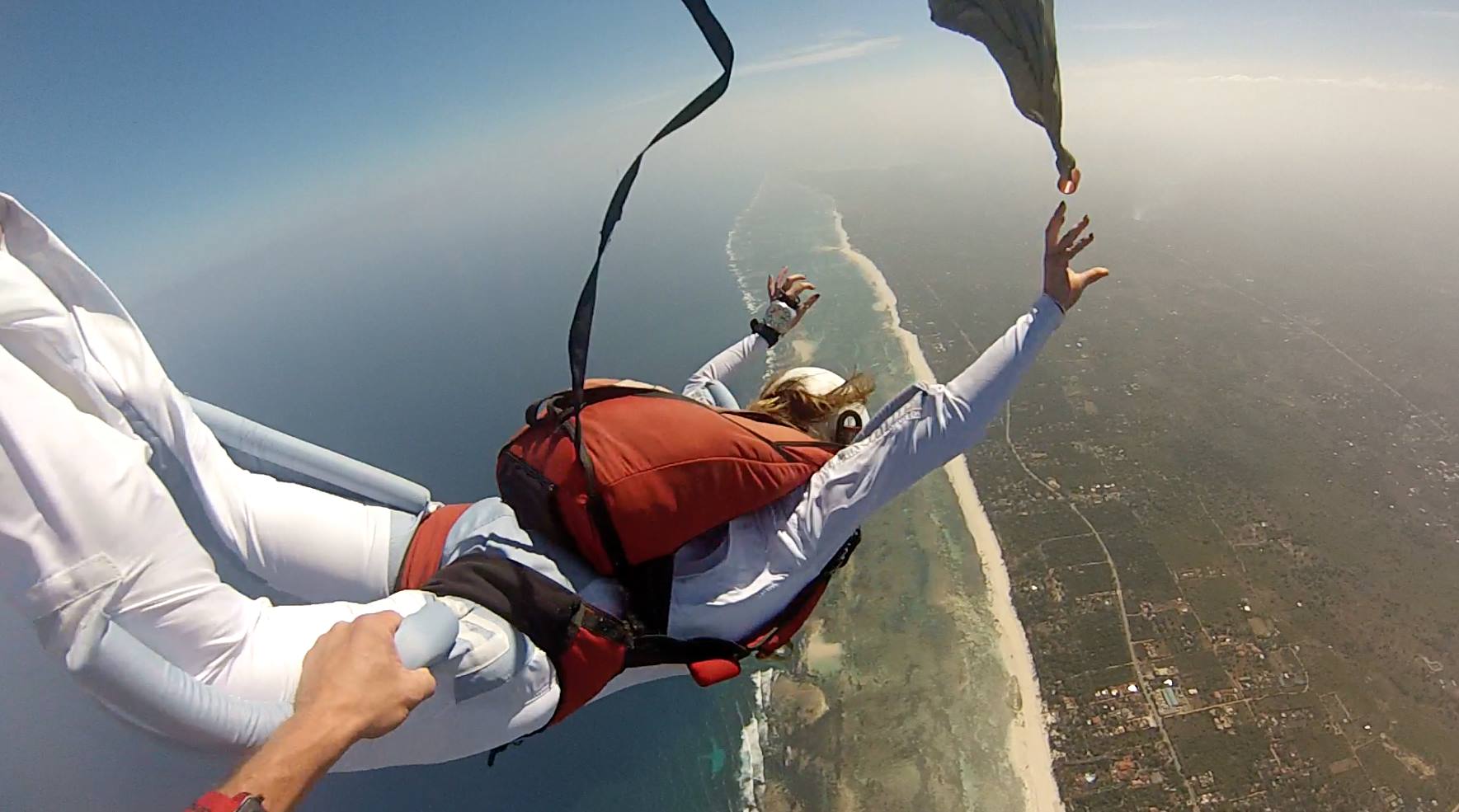Search the Community
Showing results for tags 'news'.
Found 523 results
-
Michael Huff has a hard time saying goodbye. Photo credit: Michael HuffAre you ready to be alone in the sky with a malfunctioning parachute and two little handles? Though there are skydivers with thousands of jumps who have never experienced the fun of a cutaway, don’t be fooled: it’s not a question of “if,” it’s a question of “when.” Don’t feel ready? You’re not alone – but there are a number of proven ways to boost your confidence (and, therefore, safety). 1. Stay CurrentI know. It’s not your fault. Your home DZ is seasonal – or it’s far away – or it’s a tandem factory that keeps sullen fun jumpers on the ground. Whether it is or isn’t your motivation that’s the problem, the fact remains: long lapses between jumps are dangerous. They dull skills, heighten apprehensions, create a sense of unfamiliarity with aircraft and degrade the muscle memory you have carefully built around your gear, which is of vital importance in the event of a reserve ride. It’s vital to your career as a skydiver – especially, at the beginning – to make the effort to jump every couple of weeks. Make the effort and get up there. 2. PrepareThe USPA Skydiver Information Manual puts it rather dryly: “Regular, periodic review, analysis, and practice of emergency procedures prepares you to act correctly in response to problems that arise while skydiving.” Rephrased in a slightly more compelling manner: practicing might save your life, especially if you’re a newer skydiver who isn’t quite as accustomed to the stresses of freefall as an old-timer. Here’s a two-item to-do list to tip you in the right direction: Deploy your reserve for every repack. Have you ever deployed the reserve for your current skydiving rig? If not, the result may surprise you. You’ll learn the direction of pull for your gear, as well as the force you’ll need to exert. If your rigger watches the process, he/she can watch the deployment and identify potential problems. Even if you have deployed your own reserve, a repack is an unwasteable drill opportunity. Practice emergency procedures in your DZ’s training harness. (You may feel like a dork, especially if you’ve already been skydiving for a little while. Go on a quiet weekday and do it anyway.) 3. Do The Little DanceBefore each and every jump, the USPA advises skydivers to “review the procedures to avoid emergency situations and the procedures to respond to emergencies if they occur.” This doesn’t have to mean poring over your SIM like you’re cramming for a test. It does, however, require a little bit of work before every jump--just to make sure that your muscle memory is fresh and your brain is prepared for puckersome eventualities. Touch your handles in sequence before you enter the plane. It is not beneath you. Being blasé about basic safety doesn’t make you more awesome. If you ever happen to share a plane with an energy-drink teammate or a world-class coach, watch ‘em closely and you’ll see what I mean. Check that your reserve handle is seated, while you’re at it. A loose reserve handle can deliver a reserve ride without the fun of a malfunctioning main – and you don’t want that, do you?Right! So: now you’ve done what you can to be ready for a potential reserve ride on any given skydive. Next time, we’ll talk about what to do when your main decides to give you the pop quiz.
- 5 comments
- 5
-
- emergencies
- safety
-
See more
Tagged with:
-
Just a week after the plane crash at Parachute Center near Lodi which resulted in a Cessna 208 upside down in a vineyard, another crash has occurred. This time however, with tragic results. A Cessna 182H jumpship from Skydive Kauai in Hanapepe (Hawaii) crashed early on Sunday morning shortly after take-off. All five individuals on board the aircraft died, with four being pronounced dead on the scene while another was taken to hospital, though was also later pronounced deceased. On board were two instructors, two tandem passengers and the pilot. At the time of publication most of the names of those involved had not been released to the public, with the exception of Enzo Amitrano, one of the two instructors on board. A witness to the incident claims that the aircraft had left the runway when shortly afterwards problems with the engine were experienced. The pilot is then said to have attempted to bring the plane back towards the runway when flames began to come out of the engine as it descended rapidly. There are some conflicts in media reports as to whether the fire began during the descent or only after impact, regardless the aircraft did catch alight and firefighters had extinguished the fire withnin an hour of the incident. According to the National Transportation Safety Board, the pilot involved was not familiar with the aircraft involved. Though it is not yet clear what role this may have played in the incident. Our thoughts go out to the loved ones of those involved. Discussions about this crash can be had in the incidents forum.
-
A Cessna 208 was left upside down in a field just off Jahant Road, near Lodi Airport on Thursday 12 May when the aircraft was forced to make an emergency landing. While it is unclear what caused the emergency landing and no official statement on the cause has been given -- the following was posted on the Dropzone.com forums. "One of my friends was on this load. Apparently they opened the door at 1000 feet and smelled fuel, everyone sat down and clipped in, then the engine failed and the plane landed upside down after clipping a nearby SUV. This is just what I heard, not confirmed" The owner of the dropzone had told the media that while they still weren't certain of the exact reasons behind the failure, he could confirm that the propeller had stopped spinning, forcing the landing. The plane was being operated by Parachute Center and there were eighteen individuals on board at the time of the crash. Thanks to the effect use of restraints in the plane, despite the fact that it was lying upside down, all eighteen passengers walked away from the incident without injuries. However, it was not only the passengers aboard the Cessna that found themselves subject to the situation. While making the emergency landing the plane just clipped the tail of an SUV with two individuals inside. Thankfully it was merely a small nick to the vehicle and both the driver and passenger of the vehicle walked away with nothing more than a bit of shock. Showing that nothing can keep a dedicated jumper out of the sky, several of the passengers aboard the crashed plane returned to the dropzone to continue jumping, just moments after the crash. Discussions on this incident are currently taking place in the Plane Crash - Lodi 12 May 2016 thread. Update: 16 may 2016 Footage has now been released from inside the aircraft which can be viewed below:
-
Image by Juan MayerIt happens so fast. You’re coming down from a great jump. You land, laughing, and whip around for the imminent high-five with a huge smile on your face. That smile drops right along with the friend framed in your view. Something happened in those last few feet of flight--you don’t know what, but that triumphant swoop turned into a spectacular case-in, and your friend’s screaming, and you’re running towards him at top speed, and his leg is at a crazy angle, and there’s blood. Lots of blood. What the hell do you do now? Wouldn’t you like to have a plan? Even if you have no intention of becoming a medical pro--or even a uniformed first responder--you can get a short education that might make you the deciding beneficial factor in someone’s very worst day...maybe even yours. This curriculum is comprehensive and practical, integrating the essential principles and skills required to assess and manage medical problems you might come across, especially but not specifically in isolated and extreme environments. It doesn’t have a name that implies its usefulness for skydiving, sure--”Wilderness First Responder” sounds like a course built just for Search-and-Rescue burlies--but hear me out. You need this. Here’s why. 1. Help is not always immediately at hand.Wilderness First Response certifications are meant to be used in earnest when the caregiver and receiver are essentially stranded in remote circumstances. While skydiving drop zones aren’t generally beyond the furthest reaches of civilization, they’re never in the center of it, either. Response times are not, as a rule, immediate. Any medical education is of enormous benefit, of course, but--for a regular-strength skydiver--the ROI of a WFR is pretty damn dead-on. The WFR course is about intelligent, informed self-reliance in the absence of immediate help. In the wilderness setting that the course was designed around, the priority is to figure out whether you can semi-self rescue, to assess what additional resources you need, and to methodically stabilize yourself and/or others until the cavalry rolls up. In the dropzone setting, this training is just as useful. 2. Whether or not you’re trained, you will always be the first responder to your own injuries. Make those early minutes count.If you end up injured during an emergency landing that’s outside the drop zone--and you don’t have a charged, functioning method of communication--then you’ll be waiting for help to find you. If you happen to be conscious in that interim (hooray lucky you), WFR training will give you a method for understanding your injury, stabilizing it and tracking its progress for later reporting. Without training, you’ll likely just lie there, terrified, in blinding pain--or make your injuries worse with incorrect responses. 3. You should be off the list of dead-weight liabilities and on the list of assets.Skydiving is a sport that demands proactive personal responsibility in the context of a mutually supportive, risk-educated community. We all understand this. That said: While a WFR certification does not confer the knowledge of a full EMT, it makes the bearer a much stronger member of the greater support team. A baseline education in first response moves you from a gasping member of the horrified crowd to a literate, assisting partner in incident management, though your role in the moment will, in all statistical likelihood, be quite procedurally basic. 4. You should dial up your powers of observation.We’re not just talking about cardiac arrest and gaping wounds, here. WFR training will help you recognize subtle symptoms in a way that could help you change the outcome. Dehydration? Hypoxia? Heat illness? These are real-life dropzone problems, and your awareness could make a big difference in someone’s day. 5. You’ll get important certifications.Successful completion of a WFR course will generally earn you a two-year Adult & Child CPR certification as well as the obvious Wilderness First Responder certification. This may or may not be an important piece of paper for you in a technical sense, but current CPR certification makes you a secret superhero in a world where lives are often saved by trained, responsive passers-by. 5. It’s a really good time. Seriously.Wilderness First Response courses are generally administered in, predictably, wilderness settings. I did mine with the National Outdoor Leadership School (NOLS) with the full majesty of the Yosemite Valley as the backdrop. My partner did his in the Grand Canyon country of Flagstaff, Arizona. WFR courses are offered in highly visitable settings all over the States--indeed, the world--and y’know what? There are few better-invested ways to spend a week in nature than learning life-saving, life-changing skills in a close-knit group of fellow adventurers. Y’know, like the close-knit group of fellow adventurers with whom you share your sky--and who are counting on you to be the best team member you can possibly be. Live up to it.
- 9 comments
- 6
-
- basic first aid
- safety
-
See more
Tagged with:
-
Competing for the first time as a team, the all-girl foursome of Shavon Simpson, Kim Myers, Kristen Johnson and Nada Almarr powered to the top in the 4-Way Formation Intermediate Category at the second 2016 SandStorm Scrambles event at Inflight Dubai. The foursome – the only all-girl group in the 16-team competition open to both Intermediate and Rookie skydivers – produced a stunning final jump to snatch the title after a closely-fought battle saw the four-round competition go to the wire. Combined together by the event judges in order to represent a spread of ability, the girls adopted the team name ‘The Mighty Morphing Flower Arrangers’ and certainly blossomed as a 4-Way Formation team scoring 87 points to win by seven from runners-up the ‘E-Lemon-ators’, featuring Gabor Molner, Iurri Railean, Alexander Staschenko and Janina Huschle (80 points). Also scoring 80 points but given third place due to an inferior top scoring round were Glen Lowerson, Clare Greenwood, Emma Merritt and Cornelia Mihai (‘Break Like The Wind’). “As we hadn’t flown together before and were the only all-girl team in the competition, it certainly went better than we expected,” said a delighted Shavon Simpson. “The great thing about competing with people you have never flown with before is you learn, you adapt and you have fun. “Obviously there is pressure on you as you’re not competing with your usual team-mates and you don’t want to let anyone down but it is a great format.” Staged in inflight Dubai’s 5.03m x 20.73m indoor tunnel, the two-category event saw competitors combined into teams by highly experienced judges and SkyDive Dubai instructors Eliana Rodriguez and Alena Chistova. Competition was fierce throughout as the teams performed a number of formations in the tunnel under the watchful eyes of both Rodriguez and Chistova. Going into the final round, the eventual winners were lying in third place but produced a near-flawless final performance to score 30 points – the best of the night – and take the title. “I don’t think any of us were breathing on that last jump,” added a delighted Simpson, who helped her team to the winners’ cheque of AED 16,000. “We knew we had to score well if we were going to win so we stayed completely focused on getting a big enough score. Fortunately, it paid off.” In the 4-Way Formation Rookie category, victory and the first prize of AED 12,000 went to the ‘Dutchy’s’ team of Ahmad Abdulla Hashim, Pablo Rua, Sioned Taylor and Nawaf Alawadhi on 57 points, seven ahead of the ‘Heroes and Zeros’ team of Abdulla Aldosari, Sean Hahessy, Andy Salisbury and Khaled Mahdy (50 points). Third place went to ‘Chitty Chitty Bust Bust’ comprising Khaled Abduljalil, Ana Fratila, Karim Madour and Margo Weber on 47 points. “A big thank you to everyone for making it an exciting competition,” said Meet Director Ian ‘Freddy’ Macdonald. “The Scrambles format is one of our most popular events and we look forward to staging even more indoor tunnel flying competitions in the near future.” SandStorm Scrambles Results 4-Way Formation Intermediate 1. Myers/Johnson/Almarr/Simpson 87.00 2. Molner/Railean/Staschenko/Huschle 80.00 3. Lowerson/Greenwood/Merritt/Mihai 80.00 SandStorm Scrambles Results 4-Way Formation Rookie 1. Hashim/Rua/Taylor/Alawadhi 57.00 2. Aldosari/Hahessy/Salisbury/Mahdy 50.00 3. Abduljalil/Fratila/Madour/Weber 47.00
-
Photo credit: Cornicello PhotographyiFLY Indoor Skydiving and the International Bodyflight Association (IBA) are proud to announce that Catriona (Cat) Adam has become the first woman ever to be certified as a Level Four Instructor/Trainer in the sport of indoor skydiving. Level Four Instructor/Trainer is the highest level attainable under the standards established by the International Bodyflight Association. During the 12 years iFLY and the IBA have been certifying instructors and trainers, more than 650 instructors have met IBA standards for Level One Instructors, and only about a dozen of those instructors were women. Of those Level One Instructors only about two dozen men have gone on to become Level Four Instructor/Trainers. The path to attaining Level Four Certification requires intense training, commitment, experience, the strength and ability to withstand rigorous physical demands of flying, coaching and teaching flyers from first-time flyers to world champions, and the determination to be the absolute best. Chris Dixon, Lead Instructor/Trainer at the IBA, said, “At every level, Cat made it clear she could meet or exceed the requirements for advancement; all she needed was the opportunity to excel.” iFLY’s current expansion plans have increased the need for qualified Level Four Instructor/Trainers. One of the responsibilities of Level Four Instructors is to teach the new instructors what is necessary to meet iFLY’s expansion plans. Photo credit: Cornicello Photography“iFLY is expanding, and we depend on Level Four Instructor/Trainers to teach and maintain the highest level of safety within the instructor group,” said Chris. “While many of us were hoping Cat would succeed, we also knew she and all other instructors would have to meet or exceed the safety standards expected of every other Level Four Instructor/Trainer, no exceptions. All those who know Cat are not surprised she reached her goal of becoming the best, and all of us are thrilled for her, but we also know and respect how hard she worked to master every challenge in the training and certification process. We know she will continue to be the best, share her experience and dedication to safety with others and hopefully inspire more women to join us as instructors! iFLY is better for having her on the Level Four Instructor/Trainer team.” “While I am proud of my accomplishment and appreciate the opportunities given to me to advance,” Cat said, “I must admit while watching my first class of instructors I trained working with their first class of first-time flyers, I was like a mama goose nervously watching her fledgling geese fly for the first time. I was also very proud of them and their clear focus on the safety of their new students!” Photo credit: Cornicello PhotographyCat will continue to train new instructors, help maintain and increase the safety of everyone flying in an iFLY tunnel and continue improving her personal flying skills. To Cat, the sky is not a limit; it represents limitless possibilities. Skydiving and tunnel accolades 2014 Gold : 2-way dynamic advanced IBA tunnel competition 2014 Silver : 4-way dynamic advanced IBA tunnel championships 2013 Participant : 63-way vertical world record (women’s) 2011 Participant : Freestyle Nationals (British) 2011 Participant : 80-way head down record (European) 2011 Organizer : Woman’s head down record (British) 2010 Participant : 22-way head down record (British) 2010 Participant : 41-way vertical world record (women’s) 2009 Gold : Freestyle Nationals (British) 2009 Gold : British National speed (female) About iFLY Indoor Skydiving: Austin-based iFLY Holdings, LLC is the world leader in design, manufacturing, sales and operations of wind tunnel systems for indoor skydiving. Under the brand names iFLY, SkyVenture, and Airkix, the Company has flown over 7,000,000 people in a dozen countries since launching the modern vertical wind tunnel industry in 1998. iFLY has 39 facilities operating, 15 currently in construction and another 8 planned to start construction before the end of 2015. iFLY supports and utilizes the safety and training rules set out by the International Body Fight Association (IBA) to ensure safety and progression of the sport of indoor skydiving.
-
Aerodyne recently announced the release of their new canopy, the Pilot7. This new main, which was initially developed with wingsuiters in mind, is a 7-cell variation of the popular Pilot canopy which Aerodyne have sold for over a decade. The original Pilot canopy is in fact the company's most successful product, with the 9-cell elliptical holding an average rating of 4.67/5 based off 69 votes in our gear section. Aerodyne say they found their design for the Pilot7 heavily influenced by the strengths of the initial Pilot, and wanted to ensure that the new canopy lived up to the expectations set by its older sibling. Something for EveryoneBoth beginner flyers and experienced wingsuit pilots have reportedly demoed the Pilot7 with great results and public feedback as to the performance of the canopy. The company claims the Pilot7 provides 'superbly consistent openings', while in flight offers the pilot something fun and agile, while still remaining stable and easy to fly. "It has a flat glide and a powerful flare, likely more so than any 7-cell you’ve experienced.", claim Aerodyne. It was clear that solid, reliable openings were a key factor for this canopy during development, and testimonials from those who have been demoing the Pilot7 seem to confirm that Aerodyne have really hit the nail on the head with regards to the reliability of openings. While the focus of the Pilot7 was wingsuiting, Aerodyne say they expect that the canopy may become popular in other demographics of jumpers. Due to forgiving openings, handling characteristics and low pack volumes of the canopy, it could serve as a great choice for all skydiving skill groups, however could prove especially useful for beginner skydivers. MaterialsThe standard version of the Pilot7 will come in ZP, while there are also the options for Aerodyne's honeycomb low pack volume ZPS and their new UltraLPV material. "This builds the top skin and stabilizers from ZPX, and the ribs and bottom skin from FX-11 (the low pack volume material used in the SmartLPV). We use the ZLX lines to create an amazingly low pack volume canopy." Available sizes: 117, 137, 147, 167, 187, 207, 227, 247 sq ft.
-
Image by Joel StricklandDoes exit order seem like some kind of obscure semi-religious ritual? Do you go through the motions without really understanding the moving parts? If so, yikes--but you’re certainly not alone. Luckily, understanding the logic behind the order is a pretty straightforward affair, and the entire sky will be better off if you wrap your head around it. Ready? Okay. Commit this to memory. 1. In the name of science, get the $#&$ out.It may seem like hollow tradition to hustle out the door on exit, but it’s not. As a matter of fact, there are serious calculations behind the art of exiting the plane efficiently. On a calm day, an aircraft on jump run covers around 175 feet per second of flight (that equates to a mile every 30 seconds or so). Translated into stopwatch terms, that means that--on that same calm day--no more than 60 seconds can pass from the moment the first jumpers leave the airplane to the moment the last jumper exits. For practical purposes, taking into consideration how much ground the average square canopy can cover, every jumper in the plane has to be out during a two-mile jump run. If they don’t, some are bound to land out (or a chilly second pass is going to be served up to the sulky remainder). 2. Don’t mess up the pilot’s math.If your group is about to be the first big handful of meatballs out of the plane but you suddenly split up into smaller groups, you’re messing with the pilot’s chi. After all, the jump pilot has more to calculate when he/she turns on that little green light than you might realize. He/she has to calculate about how much time each group will take to exit, and make sure the green light goes on at the correct distance from the DZ to accommodate the aforementioned 60-second countdown. As a rule, the group that will have the slowest climb-out should leave first. Big group? Light goes on farther out from the DZ to allow for a slower climb-out. Little group? The light goes on closer to the DZ. How can you help? Jump the plan you give manifest, and the pilot can give everybody a good spot. 3. Jealously guard your real estate.If you’re a Big Sky Theory kinda jumper who assumes vertical separation is going to save you from a meat-traffic collision, you are not working from scientific facts. Horizontal separation is the only separation that really counts up there, so make sure your group has a chunky slot of sky all to yourselves. Never place big bets (like: your continued existence) on your fellow skydivers pulling at the altitude they swear by. A tiny brainfart (or a big malfunction) will eat up that vertical separation before you can say “what happened to pulling at 3,500, toolbox?!.” 4. Horizon-pointing belly buttons go behind downward-pointing belly buttons.When freefly folks get out first, they tend to become part of an undelicious freefall sandwich. Here’s why: On a typical skydive, a pair of freefliers will clock a 45-second freefall and open at around 3,000 AGL. Let’s say that pair is followed by a belly group with a 10-second climb-out. This is going to sound like a math word problem, but bear with me: If one of those freefliers has a canopy with a 30MPH forward speed (which will move forward at around 45 feet per second, assuming little-to-no wind), opens 30 seconds before the belly group and turns right back toward the DZ, the variables are stacking up for a collision. Those 30 seconds of flight will drive the freeflier forward by about 1,300 horizontal feet--a measly 400 feet from the middle of the belly folks, which a solid six-second track can cover. If you add wind to the equation and the RW group gets blown even further into the path of the freefly pair, the likelihood of a meetup gets even uglier. When freefly groups get out after belly groups, the picture gets a lot healthier. The fast fallers get their horizontal separation, predicated on their shorter climb-out and faster descent rate. Wind becomes a positive safety factor instead of a negative one; slower fallers simply blow farther away. 5. With longer flights comes greater responsibility.Tracking groups, high pulls and wingsuits get to snuggle with the pilot (and/or the tandem pairs) in the way back of the plane. Why? First off, they’re mobile: if they’re doing it right, they’ll use all that horizontal power to get the hell away from jump run--and get back from a longer spot. If they’re not doing it right, however, they’re fully within their capability to truck through everybody’s personal piece of sky on the way down. The moral of the story: longer freefall (or, in the high-pull case, general airtime) requires greater awareness and responsibility on the part of the nylon pilot. 6. Don’t be the heat-seeking meat missile.That’s the bottom line, really. Everybody in the sky is counting on you. (Me, for instance.)
-
Photo by Jeff AgardJust moved across the country? Heading out to boogie in a strange new land? Impromptu road trip? If you’re not used to jumping at new-to-you DZs, reorienting yourself to a new conveyor-belt-to-the-sky is a bit daunting. But never fear, brave adventurer: if you walk in knowing what you need to do, you’ll be golden. Here’s a checklist to help make the process a little easier on you. Before you arrive:1. Do a preliminary scan for unpleasant surprises. Find out as early as possible if the dropzone (or the specific event you’re planning to jump) has special requirements that could keep you on the ground. 2. Budget. Get pricing on jump tickets, DZ accommodation and registration fees. This is a good time to check the jump-ticket refund policy and find out if there are extra charges for credit cards. 3. Ask about facilities. If you’re going to be squaring up to swampy summertime port-o-lets, miles-off RV hookups, co-ed showers (rawr) or anything else outside your comfort zone, you’ll want to know as early as possible so you can make a battle plan. 4. Make sure you’ve packed all your documentation. At the very least, you’ll need an in-date reserve repack card, your parachuting organization ID and your logbook. In some cases, you’ll also need your AAD travel documents and proof of medical insurance, too. Travel insurance is never a bad idea, either. When you arrive:1.Get the lay of the land. You’ll be spending a lot of time in the hangar and in the waiting areas, so get oriented. Pick a prime spot for your gear (hopefully, near an electrical outlet). Find the bathrooms and the fridge. Identify the load monitors, if there are any. Find out if there’s a separate window for manifest, or if the main office does it all. 2. Rock up to the office. Fill out the waiver, get a gear-and-paperwork check and buy your tickets. 3. Get briefed. You’ll likely be pounced on when you land in the office, but just in case: Pin somebody down to give you a complete briefing of the dropzone’s map and rules. Do not get on the plane without a briefing. Get clear on the manifest procedure. It seems like every DZ on the planet does this differently, and it can really get in the way if you’re not on board. Are you going to have to pay in advance, pay as you go, or pay at the end of the day? How does the ticket system work? Learn the exit order and separation rules. Many drop zones have very specific procedures in place, while others assume you should know where you belong. Watch how the local jumpers organize themselves, and ask lots of questions if you don’t get clear instruction. Check out the satellite map. You can expect a dropzone representative to use an overhead map of the dropzone and its surrounds to brief you. The rep will describe how to use recognizable landmarks to spot the dropzone from the air and review landing area obstacles, power lines, bodies of water, nasty neighbors, turbulence, the “beer line” and uneven terrain. Use this time to memorize your outs. Find out if there’s a special hard deck for this DZ. If there is one, it might be (way) higher than your personal hard deck. Check out the wind indicators. Find them on the overhead map, then peek at them in person while you take yourself on a tour of the main (and alternate, if applicable) landing areas. If there are tetrahedrons, ask if they’re trustable or if they’re “sticky.” Know the landing pattern. Landing patterns are not the same across dropzones, ranging from first-one-down-sets-it to a regular Busby Berkeley choreography of established patterns that never, ever change. Until you’ve internalized the unique rhythm, it’s best to give the main landing area a wide berth for your first handful of jumps at a new DZ. Make sure you know the rules and areas for swooping and hook turns, whether or not you plan to do them. (Don’t be the big canopy that tugboats lamely across the zoomy canopies’ path.) Figure out the loading procedure. Find out how the calls are announced and where you need to be to hear them. If there are shuttles to the plane, you’ll need to know what the call is to be on the shuttle. If there’s a retrieval from the landing area, make sure you know where it is (and hoof it over there right after touchdown).4. Get on a load! Make an organizer friend (or be your own organizer friend) and keep an open mind about what jumps you want to do. 5. Buy the good beer to share at greenlight. It’s basically, like, a housewarming that you throw for yourself. You’ll feel at home before you know it.
- 3 comments
- 2
-
- boogie safety
- safety
-
See more
Tagged with:
-
Altitude awareness is easily the most important aspect of skydiving and it’s no wonder that audible alert systems were one of the first technological inventions in the earlier days of skydiving. Like most things technical, significant advances have been made, and any device that provides information/feedback during a skydive is a valuable addition to any skydiver’s tool kit. Larsen and Brusgaard, the foremost authority on altitude-measuring/awareness devices, launched a new product named the “Quattro,” in early 2014. With four user-programmable altitude notifications/alarms, the Quattro has become incredibly popular. Why?It’s important to understand what an audible offers skydivers involved in precision activities. Once relegated only to scream at a skydiver that they’d missed their point of deployment, audibles are now used for indicating user-controlled altitude alarms, while still providing feedback for deployment, hard deck, cutaway, or other altitudes warnings. From a wingsuiting perspective, I cannot imagine anyone not owning a Quattro. With the ability to generate seven notifications in flight, wingsuiters have no reason to not be set for exact breakoff points, maneuver points, deployment, entry and exit gate-points for performance training, competition points, and the list goes on and on. Wingsuiters fall at different rates, and with radically different wingsuits, everyone has different needs and wants. With this in mind, I’ve put together a few bullet points on where the Quattro benefits wingsuiter pilots. COACHING: Frequently, wingsuit coaches have a “no more work altitude” that is different than deployment altitudes. For example, I want students to not perform tasks below 6000’ but frequently continue stable flight until 4,500. As a coach, I want these notification alarms in addition to my own personal alarms of 3,500’ and 2500’ and my hard-deck alarm at 1600’. As an FFC/First Flight Course coach, students are given specific tasks at specific altitudes on the climb to altitude. The Quattro provides three “climb to altitude” alarms that a coach might use to remind him of those points where the student should be providing feedback or information. For example, students might be giving a verbal description of the skydive at 5000’ or indicating their countdown and waveoff point at 6,000’. In any event, climb-to-altitude alarms serve a multitude of value. PERFORMANCE TRAINING: Wingsuiters competing in FAI Performance Categories need to enter their performance gate at 3000m/9842’ and exit the gate at 2000m/6562’ and while the mandatory Flysight can provide these entry/exit indicators, competitors can benefit from a pre-gate announcement that the Quattro can provide, in addition to deployment indicators. ACRO COMPETITION: In Wingsuit Acro, the competition clock starts as the competitors exit. In non-compulsory jumps, synchronization is frequently part of the jump, and having set points for an action, particularly where wingsuiters may not be facing each other (back to back flying), an alarm or series of alarms can provide valuable timing information. The multiple alarms are also good for notifying competitors when they’ve reached their competitive deck, while still providing the “standard” three alarms for deployment, reminder, and hard-deck. HIGH ALTITUDE JUMPS: Wingsuiters engaging in high altitude jumps are flummoxed that most audible systems cannot provide feedback above 10,000’. The Quattro is capable of informing the wingsuiter as high as 19,990. Although the Quattro offers a broad spectrum of alarm settings, users are not required to enable them, and this is one of the features I appreciate most about the Quattro; users may configure the system to be as personal as needed, turning on/off various alarm points. Wingsuiters focused on performance frequently do not want to look at their wrist or chest mount altimeters if they’ve got a good performance groove happening, and full-face helmets often make it impossible to see chest-mount altimeters when in a performance configuration; an audible provides valuable feedback when cranking a chin around to see a visual may have a negative impact on performance. The unit allows for offsets, so if the landing area is a different elevation than the point of take-off, audible settings can be user-adjusted if the offset is known. Otherwise, the unit will recalibrate itself every 14 hours to the last MSL point of take-off. Manually zeroing the Quattro is as easy as pressing the center button a couple of times (this is the same procedure for generating altitude off-sets). As with previous L&B; products, the Quattro uses a pair of 2325 batteries, easily found at most any electronics store or grocery store that offers a wide variety of button batteries. In my experience, the batteries seem to be good for about 1000 jumps, or about a year. However, the Quattro and Optima seem to be very forgiving when the battery indicator says “replace me.” I’ve tacked on another 300 jumps after the indicator told me I had an empty battery. While just about any discipline in skydiving can benefit from the Quattro’s numerous features, wingsuiting is one aspect of the sport that frequently demands “more.” Wingsuiters love data, feedback, and algorithms designed just for them, and the Quattro certainly delivers. It probably helps that some of the folks at L&B; are avid wingsuit pilots, and have taken time out to really dig into what makes wingsuiting and wingsuiters just “a bit different” than other skydivers, and in the Quattro, they’ve really done it well. Although I’m not a speed skydiver, I can only surmise the multiple alarms would also benefit the speed discipline. Several helmet manufacturers have recognized the value of L&B; products, and have custom-fit slots for the Quattro (or Optima2, Solo) audible, and some have given exterior access to the audible. One feature I very much appreciate in my Tonfly helmets is that I can access the audible from the outside, letting me know my altitude settings are correct, that my battery is good, and that the unit is active (I frequently turn it off if I’m not going to be jumping for a few days). The unit display turns off after 14 hours, but will reactivate if it senses a climb to altitude. Unless manually turned off, it is always ready to jump. During frequent/daily jump cycles, I don’t bother to turn off my Quattro. By the way, for the color coordination-conscious skydiver, these are available with custom-configuration buttons, just like the Optima and Viso.
-
This is a story from around a year ago when I decided to go skydiving in Australia. That day I was skydiving at Byron Bay a very nice and beautiful place to skydive, I recommend if you like to skydive and travel this is a must. The day started out really slow as the night before I was at a party with some friends. I had a headache so I just took some Advil and went on my way to the skydive spot. That day I had decided to do the 14,000 ft skydive. I talked to my instructor who was named Cody. The time was nearing until we were to start our adventure and get in the plane. It was time to get in the plane and my headache was starting to get worse. By the time we got over the drop zone I was feeling absolutely terrible. I had to throw up and my head was throbbing. We jumped out and I passed out because of all of the air pressure. We free fell for around 2 minutes, at least that is what Cody told me. But, Cody did not know that I had passed out until we had landed on the ground. He found out when we landed that I had passed out because I was not able to support my own weight with my legs because I had passed out. When I fell on the ground I hit my head and I started to bleed really badly. From what Cody told me I was immediately rushed to the hospital. When I woke up from my coma the doctors told me that I had gotten a concussion and that I had to take a ton of safety precautions for the next two weeks. That news really stunk as I was set to be in Australia for five more days and I had saved all of the most exciting stuff for the last two days. A few weeks after this incident I decided to go back to Australia to do everything I missed out on the first time I went to Australia. I decided I would go skydiving again, I decided I would go back to Byron Bay. I made sure that I would have the best experience by going to bed early and eating healthy. I did all of this to make sure that I would have one of the best skydiving experiences ever. In the morning I ate a very good breakfest in preparation for my takeoff at noon. When I went back to Byron Bay I found out that my instructor was again Cody, how ironic. We got in the plane and started to takeoff. When we got to the jump height I looked down at the scenery below. It was beautiful it was one of the nicest and prettiest places on the Earth. We got to the drop zone and I was ready to jump. We jumped out and all I could focus on was the beautiful scenery that I was falling down into. We pulled the parachute and I just floated down into paradise. And that was the story of my best skydive ever.
-
A reserve ride is an exciting adventure no matter how many jumps you have under your belt. Preparatory training is obviously the best way to ensure that you walk away unscathed, but it is my experience that the simulations we create are not as realistic as they could be. In many cases, many of us will argue, they are not as good as they need to be. The purpose of this article is to suggest possible improvements to the state of the art in emergency procedure training. If we envision beyond what we have done in the past, improvement is assured, and the safe conclusion of parachute malfunctions will increase in frequency. If we can simulate cutaway jumps more realistically, skydivers will be calmer in emergency situations, and more skillful. Elaborate simulation, in my experience, will also result in greater awareness and recall, more efficient actions, and less emotional trauma once the event is over. The first issue to be addressed by our sport as a whole is our simulation equipment. Although a vest with handles may be very helpful for establishing the general flow of handle-pulling, it is a far cry from what the event will actually feel like. Many jumpers have reported, upon landing from their first cutaway, that things did not feel or look remotely the way they expected. Handles were not where the jumper expected them to be, pull forces were not what they anticipated, nor was the feeling of the experience similar to the training process that was supposed to prepare them for this event. It is my experience, however, that when we take thoughtful steps to improve our training methods and equipment, the gap between expectation and reality can be closed significantly. The most important piece of equipment in any simulation is the mind. Creating a clear visualization of the scenario is essential, no matter how silly it may look to bystanders. The job of the Instructor in these situations is to provide insightful clarification, ideally based on their own experience. Set the emotional stage for the student in every possible way, describing the details as clearly as possible, leaving nothing out. Allow yourself to get wrapped up in the excitement that is inevitable in such experiences. This will not only make the simulation feel more real, it will help illuminate the natural mental reaction of the student to intense stress. If over-reaction or under-reaction is apparent, further training is necessary. If the student failed to perform, the instructor simply has more work to do. It continues to be my strong opinion that a suspended harness is absolutely essential for the best possible training. Given the vast amount of money we now spend on aircraft and student gear, skimping on this key element of teaching equipment is shortsighted, and most often a product of laziness and compromise. If building a hanging harness cost thousands of dollars, the financial argument might hold more merit, but this is most decidedly not the case. There are many possible methods that cost very little, and can be created in just an hour or two. I know, I build a new hanging harness at almost every dropzone I travel to in the process of running my canopy skills and safety courses. I do this because I want to offer my course participants the best possible training, and because an alarming percentage of skydiving schools have done away with this vital piece of training equipment. This needs to change if we are to improve the safety of our sport. Let's start with the actual harness. When I find suspended harnesses in use, most often the actual rig is an uncomfortable, dilapidated old rig from the early 1980's, hung from the ceiling by attachment points that are way too close together to simulate a realistic experience. In the best cases, there is a three-ring setup that allows the jumper to cut away and drop a few inches. This is a great training aid, but what if the rig was a more modern adjustable harness that could accurately reflect the fit and handle placement of the rig they will actually be jumping? For that matter, what if we hung them in the rig they were actually going to jump? What if the suspension apparatus was long enough to practice kicking out of line-twists? What if the toggles simulated the resistance of an actual parachute using bungees or weights? What if you pulled on straps attached to the bottom of the harness each time they flared, to simulate the pitch change? What if, as crazy as it sounds, you went to the local hardware store and picked up a high-powered carpet blower, a.k.a. “snail fan”, and angled it up at the harness to reflect the feeling of the relative wind? This is the kind of outside-the-box thinking that creates better simulations, and better training. Further, this is how we prepare our students for an actual malfunction and reduce the risk of pilot error. For experienced jumpers, I highly recommend hanging up in your own rig. This will clarify handle placement under load, allow you to explore strap tightness possibilities, and give you the opportunity to experience actual pull forces when your repack cycle is up. If you do not have stainless steel hardware on your rings, please use fabric connection points rather than the carabiner attachment displayed in these photos. Another key element of malfunction simulation is to follow through with the complete jump, rather than stopping after the handles are pulled. In reality, the adequate performance of emergency procedures is just the first in a long list of steps that lead to a safe landing. For instance, what if the cutaway harness had Velcro reserve toggles that needed to be first peeled upward and then pulled downward? Many people, myself included, have tried simply pulling the reserve toggles downward to find that they would not release. Missing details like this can lead to a student feeling more angst than is necessary, and can result in further stress-induced mistakes with major consequences. Additionally, proper exploration of the reserve canopy is important for a good flight pattern, accuracy and landing flare following a malfunction. How much slack is in the brake lines? Where is the stall point? What is the flare response on this brand new canopy? A good cutaway followed by a broken ankle on landing is still a bad day. Simulate the whole jump, and there will be fewer surprises. The final issue I want to cover on the topic of better emergency procedures training is the inclusion of deliberate adrenaline management efforts following the deployment of the reserve canopy. Carrying the emotional momentum of a malfunction all the way to the ground definitely increases the chances of a lousy landing. High levels of stress takes time to sluff-off, but a skilled operator also knows how and when to slow down. Once you have pulled all the handles you need to pull, taking three long, slow, deep breaths while gazing at the horizon with a smile of relief on your face can change your mood, and your fate. Get your composure back, and your optimism will follow. From there, skill is just a short step away. This process can and should be included in every emergency procedure simulation to create a habit that is likely to be carried out in the sky. Following such quiescent procedures allows the mind to more easily let go of the recent past and focus on the present moment and the near future: 1) Check altitude and location 2) Find a safe landing area 3) Explore the reserve 4) Fly a good pattern 5) Flare beautifully 6) Walk away with a smile on your face 7) Thank your rigger A malfunction does not need to be viewed as an emergency, especially if you are truly prepared; it is just a change of plans. A complete simulation can be the difference between a horrifying emergency and a well-executed contingency plan. If we handle it well, a main parachute malfunction can actually be fun. I have found few experiences more rewarding than a complicated situation that I figured out on the fly, and despite my fear, I kept my head and did the right thing. In short, a parachute malfunction is an opportunity to prove to yourself and the world that you can handle yourself in a crisis, and with realistic training, your success can be an inevitable conclusion. About the Author: Brian Germain is a parachute designer, author, teacher, radio personality, keynote speaker with over 15,000 jumps, and has been an active skydiver for 30 years. He is the creator of the famed instructional video "No Sweat: Parachute Packing Made Easy", as well as the critically acclaimed book The Parachute and its Pilot. You can get more of Brian’s teaching at Adventure Wisdom, Big Air Sportz, Transcending Fear, and on his vast YouTube Channel
- 5 comments
- 5
-
- emergencies
- safety
-
See more
Tagged with:
-
Image by Joe NesbittLast week, we talked about the mighty kerfuffle that is the pilot-chute-in-tow malfunction. So...who wants to have one? Nobody! Right. So now that we’ve established that, we can get down to the business of avoiding the hell out of those. There are four big steps you can take to lessen your risk of a PCiT, and there’s a good chance you’re currently messing up at least one of them. 1.Cock it up (so it doesn’t cock your jump up).Your collapsible pilot chute is a demanding partner. Her deal is this: no foreplay, no canopy. Most of the time, you’re good about it. You guys have a really established routine at this point, right? From the time you’ve got your nylon laid out on the floor to the time you wrap your legs around it to finish it off, you follow a very predictable routine. Somewhere in there, you give that collapsible pilot chute a tug and get her indicator window nice and blue. Everybody’s happy. But what happens when you get distracted? If you end up ignoring your PC for a surprise debrief or a dance break or an awkward conversation with the meaty contents of the best-fitting freefly suit you’ve seen all week, make no mistake: she’s going to get her revenge. Failure to cock the collapsible pilot chute, after all, is the leading statistical cause of PCiTs. The solution here is simple: focus. Give your pack job the attention it deserves, in the same order every time. (It’s never a bad idea to include that little indicator window on a quick gear check, either.) 2. Do what you’re told.I know. You’re the boss of you, and I’m not your real mom, and manufacturers are basically like corporate drones, and the USPA is a bunch of guys throwing canes and slippers at kids who merrily chase balls onto their collective lawn. You do what you want. That said: maybe you should do what you’re told every once in awhile. This is revolutionary stuff, I know. But the manufacturers’ instructions for bridle routing and main-flap-closing aren’t just there to give you something else to toss giddily out of the box when your new container arrives. As any pro packer will tell you, those yawn-inducing closing procedures differ dramatically between brands. If you’re using the wrong one for your particular equipment, you’re setting yourself up for a container lock. 3. Watch the news.Along those lines: be on the lookout for updates. Remember a few years back, when all those photos came out of closing pins stabbing neatly through the middle of their bridles? It kinda looked like a fabric samurai drama, but it was pretty serious -- several jumpers, jumping different equipment, experienced pilot-chutes-in-tow in this same manner. In response, manufacturers posted updates to their manuals, changing the closing procedures for their containers to lessen the risk. The moral of the story is this: Maybe you’re still doin’ it the old way and have managed to be lucky so far. (Emphasis on: so far.) You can also investigate pull-out -- as opposed to throw-out -- pilot chute systems, if you like to be on the oddball end of technology. 4. Embrace the transient nature of our linear existence.Nothing is forever, dear reader. All seasons pass. All kittens turn into old cats. Your pilot chute and bridle will eventually wear out. Thus is the way of the world. We know you love your pilot chute and bridle. They love you back. They yank that nylon out of the bag for you over and over and over without complaint. They get dragged across the grass and the filthy packing mat and the Arizona desert for you. They get stepped on and sat on and waved around willy-nilly when you need to get someone’s attention on the other side of the hangar. But they can’t do it forever. Collapsible pilot chutes lose effectiveness when their little kill lines shrink. If that line shortens to the point that the PC can’t inflate fully, you will probably end up with a dead pilot chute flapping around above you in freefall while you count to yourself in your helmet. Insufficient drag to pull the closing pin = PCiT. Like many existential tragedies, this doesn’t happen overnight. Have you noticed little hesitations after you throw? Are they getting longer? Have you noticed the aging process creeping up on your little bitty sub-parachute in the form of obvious wear? Cuddle up on the couch with her, read The Velveteen Rabbit together, cry a little bit and give your old, loyal PC a Viking funeral. She deserves it.
- 8 comments
- 7
-
- emergencies
- safety
-
See more
Tagged with:
-
Curt Vogelsang captures some hot canopy-on-canopy action. Y’know when you don't feel like getting out of bed in the morning? Your main parachute is likely a lot brighter-eyed and bushier-tailed than you are, but every once in a good long while it just doesn't feel like getting out and doing its job. Y’know? Relatable. Kidding aside: When you throw your hand-deployed pilot chute but the container stays closed -- trapping the main deployment bag inside, helpless to deliver you a parachute -- you’ve gotchaself a pilot-chute-in-tow. In other words: you’ve got nothing out, which makes you the clenchy, concerned (and hopefully very temporary) owner of a high-speed mal. You’d better get on that, buddy. Stat. But how? Deploy the reserve immediately or cut away first and then deploy the reserve? One Handle or Two Handles: The Cagematch If you’re not sure which you’d choose,* you’re certainly not the first. This particular point has been the subject of roaring contention since the invention of the BOC, my friends. (Guaranteed: the comments section below will corroborate my statement. I can sense people sharpening their claymores and dunking their arrows in poison even now.) There’s a school that says -- well, duh -- get your damn reserve out, like right now what are you waiting for. There’s another school that calls that school a bunch of mouth-breathing pasteeaters. The latter group insists that you'd better go through the procedures you know lest you mess it up when it counts. They usually follow up by spitting on a photograph of the first group’s mother and wondering aloud why the first group is even allowed to skydive. Then they start punching each other. Images by Joe Nesbitt The USPA Skydiver’s Information Manual doesn’t make a move to break up the fight. It stands clear of the flying arms and legs and says, “Y’know -- they both kinda have a point.” Section 5-1 of the manual says this, verbatim: “Procedure 1: Pull the reserve immediately. A pilot-chute-in-tow malfunction is associated with a high descent rate and requires immediate action. The chance of a main-reserve entanglement is slim, and valuable time and altitude could be lost by initiating a cutaway prior to deploying the reserve. Be prepared to cut away. “Procedure 2: Cut away, then immediately deploy the reserve. Because there is a chance the main could deploy during or as a result of reserve activation, a cutaway might be the best response in some situations.” Let’s look a little closer at the options, then, shall we? Option One: Not Even Gonna Bother With That Cutaway Handle. Pro: Immediately yanking out that reserve saves a step. When AGL counts (and golly, doesn’t it?), saving a step can save a life. Many skydivers are quick to point out specific incidents in which jumpers with PCiTs have gone in with sealed magical backpacks, having failed to pull both handles (or pull any handle at all) while the clock was ticking. Gulp. Con: It takes the pressure off (in a potentially bad way). As the reserve leaves the container, there’s a chance that it can take the sealing pressure off the flaps that are keeping the main container closed. The main can then leap to freedom and deploy at the same time as the reserve. At this point, you might wind up with an entanglement, a side-by-side, biplane or downplane to figure out.** Option Two: Get Off The Field, Main Parachute. Reserve, You’re In! Pro: It’s the same stuff you’ve been taught to do for every other reserve-requisite malfunction. ...If you initiate the reserve deployment clearly, confidently, and as early as possible, of course. After all: making a one-off exception for a single kind of malfunction can be tricky. A jumper might well spend a little too much time thinking it over (‘Am I going for my reserve handle first right now? ‘Cause that’s weird. Is that okay?’) when they should just be yanking the stuffing out of their emergency handles. Going through the real-life motions of the little dance you do before you get on every load makes more sense to your body, for sure. Con: You’re adding more complexity to the situation than you may realize. Especially if you don’t have secure riser covers, the (jealous?) cut-away main risers might sneak out of the container and grab for the reserve as it deploys. Another thing: the main is very likely to wiggle free, detach from the harness as soon as it catches air and do its best to entangle with your Option B. The latter kerfuffle is made much more likely when you add a single-sided reserve static line to the mix, turning the already-dismaying situation into something of a tug-of-war. Neither of these choices sounds like the cherry on top of a lovely afternoon; I know. At some point, however, you may be forced to make one. If you do, you’d better have a plan in mind. Not in the mood to make that choice? Me neither. Luckily, there are some steps you can take to better your chances of never seeing a PCiT -- and in next week’s article, I’ll tell you what they are. --------- *If you have a Racer (or any container with a cross-connected RSL), you do not have a choice. You must pull the reserve without cutting away. Do not pass ‘go,’ do not collect $200. In that particular configuration, the main will choke off the reserve if the cutaway has been pulled. If this unnerves you, get thee to a rigger to discuss it. **Head over the PIA.com to check out a handy study they did in 1997 regarding the management of two-out situations. It’s called the “Dual Square Report.”
- 9 comments
- 8
-
- emergencies
- safety
-
See more
Tagged with:
-
NZ Aerosports released the original Icarus Safire in 1999. They followed up in 2001 with the release of the Safire2, and she went on to become their biggest selling mainstream canopy, and one of the most popular beginner and intermediate canopies on the market. About five years ago, there began to be rumours of a Safire 3 and Crossfire 3 being developed, but the development of Petra and Leia stole the limelight and the research and development hours, and kept the company preoccupied for a few years. But last year NZ Aerosports started making some noise about them again, and since there's been a few teaser posts on their Facebook page about these new wings. Everyone wants to know when the Safire 3 and Crossfire 3 will be released, but the team at NZ Aerosports are staying tight lipped on that one. They have stated that the Safire 3 will be first to go public. And they've released a bit of information about what we can expect to see in the Safire 2's successor. They say they are also working hard on the Crossfire 3 project and that it’s going to be ready later in the year than the Safire 3, but it’s looking pretty good! The starting point for the Safire 3 project was reshaping the Safire 2 in the same software and using the same 3D design technique used to design Petra and Leia. They’ve kept the crossport design and repartition the same, to reduce surface distortion and improve load bearing, and the 3D lineset design, which gives a more accurate shape in flight. They’ve used the same elliptical lobe, so the shape of the canopy given by the way the lineset attaches now follows a true ellipse. And they’ve added their statement Powerband that flattens the 3D panels more accurately and reduces fabric stretch to keep the new design true to it’s shape in flight. These are some of the design changes you can expect from the Safire 2 to Safire 3: New planform totally reshaped through true 3D design Proportionally tuned air inlets that open wider in the centre of the canopy and less toward the tips New brake configuration, providing a more efficient flareIt won't be more 'high performance' than the Safire 2, because it is aimed at the same type of pilot that flies them now, but she will be more efficient and responsive, have a better glide and an even more powerful flare. The Safire3 Project: Opening Progression from NZ Aerosports Ltd on Vimeo. When the Safire 3 comes to market she will be available exclusively from NZ Aerosports in New Zealand, and NZ Aerosports dealers.
-
Just before the Super Bowl 50 yesterday, an ad was aired on CBS that no doubt had a lot of skydivers sitting back going "Hell yeah". For those that jump, and happen to be a fan of football, the two and a half minute video was a hybrid of awesomeness. As 7 skydivers (Marshall Miller, Steve Curtis, Jesse Hall, Travis Fienhage, Jonathon Curtis, Chris Argyle, Mike Chapman) in full football gear begin a game at altitude. Using people jumping out of planes to sell products is nothing new, but this project seemed distant from the generic mid-air product placement. Instead, we got to see what it would be like if a group of skydivers exited the plane and engaged in a game of in-flight football. The cinematography was excellent and it's not too often we get to see aerial footage shot using the illustrious Red Dragon, filming at 6k. "A huge thanks to Pepsi and Papa John’s for supporting us in creating this epic moment!A huge thanks to the Whistle Sports team for all their support on this project. Whistle Sports is made up of sports creators, brands, leagues, teams, events and athletes who make content for the new generation of fans. Music is called 'The Darkness (Remix)' by Built By Titan. Film by Devin Graham and Tyson Henderson Produced by Carter Hogan Edit by Tyson Henderson using Adobe Premiere Pro CC Sound Design by Dan Pugsley Aerial Cinematographer: Jon Devore Super thanks to Temp Media for providing the amazing aerials with the C-130. They were all captured on the Red Dragon in 6K with the Shotover. If anyone is interesting in aerial services they can go to our website www.temptmediafilms.com Skydive Team - These guys are AMAZING athletes and were complete ninjas in the sky! Marshall Miller Steve Curtis Jesse Hall Travis Fienhage Jonathon Curtis Chris Argyle" A behind the scenes video was also made available on youtube, and can be watched below...
-
Skydive Arizona began in the early 1990s when formation skydiving was dominating the scene and freeflying was just starting to become popular. Skydive Arizona has been the training grounds since then of fostering a great skydiver because of the weather, on-site wind tunnel, and access to multiple turbine aircraft. The DZ is thrilled to announce exciting changes to some of the classic events for the 2016 season! Skydive Arizona has retired some long-standing traditional events such as the Valentines 4-Way FS Meet and Turbine Madness. The Valentine’s 4-Way FS Meet was a staple of a formation skydiver’s experience. However, with the access to turbines and tunnels, the event saw a decline and decided to retire the event. The Turbine Madness will now focus on the Challenge which will also see a few new additions. Airspeed Big Way Camp Changes to current, annual events: The Arizona Challenge organized by Arizona Airspeed for formation skydivers will add Arizona X-Force organizing a Vertical Sequential Challenge. The Freefly Money Meet which was a scrambles-style event, is now the MFS (Mixed Formation Skydiving) Money Meet. The MFS style event is meant to be a platform for National competitors to train. MFS Money Meet All boogies that Skydive Arizona hosts (Easter Boogie, Patriot’s Boogie, Halloween Boogie, Thanksgiving Boogie, and the Christmas Boogie) will continue to include camps in various disciplines. An incredible new event is slated for this November 3rd – 6th called, The Wingsuit Rally. The format of the event is to be an educational extravaganza from First Flight Courses to preparing for Wingsuit BASE to seminars, suit demos, state records and more. Wingsuit coaches that have confirmed include: Katie Hansen, Scotty Bob, Doogs, Taya Weiss, Jay Moledzki, Travis Milke, Petter Mazetta, and Matt Frolich. Vendors are still confirming at this time. Wingsuit Rally Upcoming Events:Airspeed Big Ways -- Registration: $50/person (February 12-14) MFS Money Meet -- Registration: $200/team (February 20-21) VFS Challenge -- Registration: TBD (May 28 – 30) Patriot’s Boogie -- Registration: $25/person (July 2-3) US Nationals (October 19-30) Halloween Boogie -- Registration: FREE (October 29-30) Wingsuit Rally -- Registration: $50/person (November 3-6) Thanksgiving Boogie -- Regisration: FREE (November 24-27) Christmas Boogie -- Registration: TBD (December 24 – January 1) Collegiates (December 28 – January 2) For detailed event information, go to www.SkydiveAZ.com/experiened/events.
-
Squirrel are soon releasing their Swift 2 and Funk 2 wingsuits, which are now available for pre-orders. We're excited to bring you this first look at the Swift 2. Image by Dan Dupuis New smaller planform New profile New leading edge construction New arm sweep More R&D; per square inch than any suit in its class The SWIFT 2 is an entirely new design that brings a higher level of efficiency and performance to the beginner-intermediate class. This is the most balanced and versatile beginner-intermediate design that we have flown, and we think it represents a meaningful step forward in wingsuit design. In the same way that the FREAK has upset the intermediate class market, the SWIFT 2 offers performance and ease of use in a ratio that we think is unique in the category. Compared to the SWIFT, the SWIFT 2 has less surface area yet more glide performance, range, and speed. What this means is that the SWIFT 2 is easier to fly than its predecessor, and offers higher performance. This has been accomplished by increasing efficiency in the profile and planform. Traditionally, wingsuit manufacturers have added surface area to a design in order to increase “performance”. But, as surface area increases, so does difficulty. Surface area is the one factor in wingsuit design that cannot be cheated: if it’s bigger, it’s potentially more difficult to fly. Our mission at Squirrel is to maximize the efficiency of each design by focusing on glide and speed gains that come as a result of profile improvements and drag reduction, instead of simply increasing surface area. When we increase the performance of a suit without reducing the comfort and ease of use, it can be considered a “free” upgrade. That is the focus of the SWIFT 2. Image by Avalon WolfThe SWIFT 2 planform has less arm wing surface at the wingtip section of the span, increasing the aspect ratio and improving handling and ease of use. The wing root chord has been slightly increased, adding range and stability particularly in applications such as flocking. The added surface at the wing root enables smoother pitch adjustment and increases roll stability by supporting the pilot’s CG and hips. This also eases transitions from belly to back fly positions. The leg wing stance is also narrower than the original SWIFT. A new arm sweep and leading edge construction, taken directly from the FREAK, has reduced drag and improved agility. The SWIFT 2 feels considerably more compact than its predecessor, or any other wing in its class, thanks to these factors being combined with a profile also adapted from the FREAK. The FREAK profile was chosen for its moderate thickness and excellent behavior across a wide range of speeds. THE RANGE Versatility is a key tenet of the SWIFT 2 design. Arm and leg wing pressure can be adjusted via the internal wing zips, allowing a softer and more manageable ride for newer pilots, acrobatic pilots looking for rapid transition and ease in flips where wing area has to be rapidly compressed. With zips closed, the SWIFT 2 delivers the range, performance, and stability needed for high or low speed flocking. INLETS The SWIFT 2 inlets are adapted from our newest high-performance suits, and feature a more efficient intake with less drag than the original SWIFT. Back-fly inlets are offered as an option, and make the SWIFT 2 a fun and agile suit for freestyle flying and steeper, more advanced, formations. LEADING EDGE Leading edge construction is a complicated matter in wingsuit design. Performance can be enhanced by creating a rigid structure over the arm, but this results in a significant reduction in passive safety. We have focused on this part of our wingsuits since the beginning of our development and we are constantly striving to create the best balance of comfort and performance. The SWIFT 2 leading edge is adapted from the FREAK, and features a grained non-flexible main arm segment with a flexible Glideskin arc at the wrist for BOC and riser/brake toggle access. The interior is finished in Lycra, which provides a smooth surface for skin or clothing to slide across, and houses the optional leading edge foam. Never underestimate the importance of an easy pull and access to your risers. Brake and riser access is a learned skill: practice it thoroughly! PLANFORM The SWIFT 2 planform is completely new, and was chosen for its distribution of surface at the wing tip and wing root. Additionally, the sweep and stance are similar to the FREAK and FUNK 2, making the transition to our more advanced suits feel more natural. PROFILE The SWIFT 2 profile is adapted from the FREAK, modified only to fit the smaller planform and shorter chord. Thickness and camber was chosen for stability across a wide range of speeds and angles of attack. Image by Luis Lopez MendezFEATURES We believe that all performance-enhancing features in a wingsuit should be standard. If it's important to performance flying or improves ease-of-use, then it's included in the price of your suit. Padded and reinforced foot cavities, chest pocket / belly-cam access, internal pressure-zips, nut-sack storage compartment, mylar reinforced leading edge, and rubber BASE soles are all standard features in all of our suits. ACCESS In BASE and Skydiving, easy BOC and brake toggle access has proven to yield the safest and most reliable deployments. We firmly believe in the mantra, "Keep it Simple and Safe". For that reason, we designed a suit for which arm cutaways are unnecessary, BOC access is clean thanks to the extended wing root that helps to prevent the trailing edge from covering your PC, and risers / brake toggles can be accessed without unzipping. The arm sweep, wrist-cut, and leading edge construction have all been engineered for a balance of safety and performance. PERFORMANCE The SWIFT 2 has an exceptional amount of performance for its surface area. No other suit in this size range delivers as much speed, glide, or range. Ease of use is a critical factor for this class of suit, and the newest pilots will instantly appreciate the SWIFT 2’s stability in an arched position. If you have questions about flying your SWIFT 2 at any level of performance, please don't hesitate to contact us! We are always here to answer your questions.
-
I often get asked by Whuffos "Why do you jump out of planes?" At first it's always fun to say "Because the door was open" and after a few laughs I try to explain. I try to explain the 60 seconds of absolute peace. That 1 minute that nothing else matters and you're 100% focused on the moment and what you're doing. To a non jumper that explanation isn't ever really good enough I feel, and often refer to the cliche quote of "To those that jump, no explanation is necessary, and to those that don't, no explanation is possible" Because it's the closest thing to the truth. I feel lucky to be apart of a community of amazing people! People that put aside status, careers, race, politics and are so excited to share the amazing sport of skydiving with new jumpers like myself. I didn’t know that about skydivers when I did my first tandem jump, nor did I know that I would end up traveling all over the US, meeting people from all walks of life, people I would end up calling friends and my sky family. However, one thing I do now know, is how thankful I am to have started this journey. Everything started for me on October 14th 2013 and the set of upcoming random circumstances would lead me to so many different Dropzones around the US, which resulted in me being asked to write this story. I was working in an industry where it was common to work really hard for 4-5 months and then take a couple months off. Right after my work season ended I decided I was going to skydive. A decision I arrived at due to various circumstances I found myself in. I was previously in the army and broke my foot the week before airborne school and always regretted not being able to jump and be apart of an airborne unit in the army. A few years after that I was working on my pilots license at a very small airport in Goshen Indiana that had a small skydiving operation on the other side of the field. Other than hearing "Jumpers Away" and making sure I didn't hit any of them while practicing take off and landings I never made it over there, even though I told myself repeatedly that I would try. Then a couple years later I met a guy by the name of Tim Kelly, randomly on a cruise ship and he had just started his skydiving training a few months before and was so excited to share with me his excitement and how awesome the sport of skydiving was! These events always left me wondering if I would take the time away from flying and scuba diving to start a new hobby. Getting LicensedSo there I was in La Porte, IN several years later and woke up one morning and decided today is the day! I'm gonna jump out of a plane! I called all the Chicago DZ's and none of them could take me because I weighed 260 lbs. so I called around the Indianapolis area and it was the same result. A friend told me "I think they jump over in Plymouth call them" At this point I was pretty discouraged, but I had already made up my mind that somehow I was going to do a skydive! I couldn't believe that all the big operations couldn't accommodate me, but somehow the little DZ 25 min down the road might be able to. I called them up with my situation, desperate to jump, and the DZO said "Come on in. We will take a look at you and depending on your height and build we can take you if it's safe to do so". Dropzone #1! I hopped in the car alone and drove straight to the DZ! After arriving a gentleman named Steve Verner came over and after weighing me and sizing me up decided that it was no problem. The main parachute was rated for our combined weight and he was more than confident (with over 10,000 jumps) to safely take me on a tandem skydive. I was beyond stoked! And started filling out paperwork, watching the mandatory videos and soaking up every bit of instruction Steve was giving me. The plane ride up consisted of Troy the DZO and Pilot on that day, Steve my Tandem Instructor and his wife Jenny the videographer. It was a 20 minute ride of smiling, while also refreshing everything I had learned on the ground. I was very impressed at all the attention that was put into safety! 10,000 feet, door opens, head back followed by 40 seconds of amazement! As soon as we landed I said I have to learn how to this! I don't care what it takes, let's get started! That day I filled out a USPA membership application and scheduled ground school, along with my 2nd mandatory tandem, which I scheduled for the next day at the same DZ (Plymouth Sky Sports). After completing my ground school and 2nd tandem the next day I bought my first Cookie G3 Helmet. I was also measured and even ordered my first jumpsuit. I was already committing to the sport after only 2 jumps! The Dropzone would be closing for the winter 2 weeks later and the upcoming weather wasn't looking great either. I would have to wait until the next season or travel somewhere warmer to continue training, which is exactly what I did! Dropzone #2 I called several Dropzones in Florida because I was told that with my weight and being a student, I would need a 300 sq ft Canopy to start my training (300lb Exit weight). After about my 5th call the Florida Skydiving Center in Lake Wales Florida, they told me to come on down! They had a rig that would fit me and instructors to provide the training. 1 week later I rented a small 1 bedroom house in Lake Wales and walked into the DZ to fill out paperwork. After spending a few days on a weather hold I decided to drive up to Deland and order my first container from Mirage. Apparently most people don't order their first rig until they know they are going to make it through the training, but I was committed and in my mind there was no turning back! The manager measured me and helped me design my custom green and black colors and then the wait would begin! 2 days later after a very successful AFF Level 1 skydive and a very bad no flare/no wind landing that left me wondering if I could even stand up or wave my arm to ensure my instructor I was ok (as he pleaded with me over the radio). As I heard the words "Holy Shit Bro, are you alive?" coming from a golf cart that was approaching me, I learned there was a lot more to skydiving than simply jumping out of a plane. Yes, I was alive. It was while being driven back to the hangar on the golf cart that I learned the importance of a flare. 6 hours later while in the emergency room at the VA hospital in Orlando I would also learn that a mans ACL doesn't agree with 300lbs falling from the sky without a proper flare. A lesson I wouldn't forget. Dropzone #3 4 months later I was fully healed up and working in San Antonio Texas. This is where I would resume my training at Skydive San Marcos. My new rig was completed and I showed up at the DZ looking like a seasoned pro in my bright colored jumpsuit, helmet and new rig (but still had no idea what I was really doing). They would confuse me for a licensed fun jumper who was waiting to fill out a waiver when I was really there to start with my 4th overall jump and only my 2nd solo! After telling them an interesting story and that I was actually brand new they paired me up with 3 of the most amazing instructors I have met to date. Hank, Kevin & Pun. These were the guys that would train me now that I was healed, give me my confidence back and nurse me through 3 months of weather holds and countless times riding the plane down with other students, due to the winds kicked up too high. I stayed at San Marcos through jump 15, when a new Dropzone opened not far down the road. I ended up taking a trip there with some of my new skydiving buddies to check it out. Dropzone #4 I decided to continue my training at Skydive Lonestar because at this point I was on coach jumps and they would allow me to use the new rig I had sitting in my car. Something the other DZ wouldn't allow me to do per their rules. This would save me gear rental fees and allow me to start getting comfortable in my own rig. The Dropzone had only been open a week and I would be their first AFF student. The staff and DZO was amazing, salt of the earth people. For days and days they would send the Otter up with only 6 or so people just so new guys could jump and I could keep training. I would always be grateful for this and wouldn't realize until later how rare it was. I would complete another 5 jumps there before moving to Houston. Dropzone #5 I moved to Houston and Skydive Spaceland would become my new home for a while and 5 jumps later I earned my A license! It felt great to finally be a real skydiver because it had been 9 months, 5 Dropzones, several instructors and 1 injury later that I was finally able to achieve this goal. I would then learn the meaning of "BEER!" As I got my A license and stamp at Skydive Spaceland. I would learn that tradition again a few weeks later when I would biff my landing and my cutaway handle would be pulled between myself and the ground while sliding 10 feet across wet grass. (I guess that doesn't happen a lot and I have yet to see it happen again) It was apparent when the skydiver picking up his canopy 30 feet from me yelled "How the fuck did that happen! I have never seen a reserve pilot chute pop out while someone was sliding across the ground before! I bet you owe beer for that one!” Needless to say the gas station down the street would get to know me well in those first weeks. Dropzones 6-77 Over the next year while traveling all around the country for work and taking some trips, going hours and even hundreds of miles out of the way just to jump at a new Dropzone I would figure out why I was traveling to all these DZs. I loved to jump, as anyone that completes training does I'm sure, but I found that in all my life that skydivers was the most interesting and awesome people that I have ever met. They are the only group of people (besides poker players) that you could sit amongst people without worrying about class, race, work status and discuss something you truly loved and share stories and drink beer and it would never get old. A member of the PD factory team would jump with you just to help you learn, guys and girls with thousands of jumps would share there knowledge and not make you feel inferior; But instead would share their experiences to help better everyone around them. I figured as long as I was traveling anyway I would make it a point to go to as many Dropzones and boogies and I could and seek out these amazing people to hear there stories and learn from them. Heading For 100It was probably about Dropzone 20 or so that I was jumping with new friends and the fact came up on how many DZs I have been to. It wasn’t strange to me to travel all over the country for work or to find new dropzones because i desperately wanted to keep jumping! However to my new friends that always jumped at the same DZ since they got licensed they found it very interesting because in a lot of cases 1 plane is all they knew. I met 100’s of people that had only jumped from a 4 person Cessna and nothing bigger. I decided then that since I was able to travel, that I was going to make it a goal to visit 100 Dropzones and try to jump at as many as I could, and from as many different planes, helicopters and balloons that I could. I knew weather would play a part and some places would only take tandems, but I was gonna do my best and just have fun with it. I started taking the "Selfies" next to the DZ sign early on to document my journey. Several years earlier I drove to all 48 continental states and did the same thing. A lot of people watched my journey on Facebook and thought it was fun, so I thought it would be a good idea for skydiving as long as I was out here doing it anyway. More of Justin's images can be seen on his Dropzone.com profile Common QuestionsNow I could write pages and pages about my experiences, stories, boogies, jumps etc etc. But as I travel and people find out that I have jumped so many places and will continue to I get a lot of the same questions which I'm always happy to answer and still developing new answers as I jump. So I wanted to share a few of those Q&A;'s at the request of Dropzone.com and because I know I had a lot of the same questions about different places. 1. What's the nicest Dropzone you have been to? That's a hard one to answer because there are a lot of nice DZ's. However my personal choice is CSC (Chicagoland Skydiving Center) Their facilities are amazing, all there rental equipment is top notch. The staff there go above and beyond to welcome new people to the sport and they have the nicest gear shop and restaurant in the country in my opinion. It was pretty much built for skydiving. The DZO is one of the friendliest guys you would wanna know. I don't just mean a friendly skydiver but Doug is just a pleasant friendly person in general and his attention to detail in running his operation is second to none. All of these things make it the nicest facility that I have had the privilege of jumping at. 2. What's your favorite Dropzone? Always a difficult one to answer because it's really a 6 way tie for different reasons and the people that jump and work at these Dropzones make them a great time not only to jump at but to also hang around and have fun. They also all have a very high level of respect for safety and people willing to help you learn from your mistakes when you mess up. Those would be Skydive Windy City in Michigan City, IN. Skydive Spaceland In Texas, Chicago Land Skydiving, Skydive Chicago, Skydive Lonestar and Skydive San Marcos. I have jumped at these places more than any other and I have good friends at each of these DZ's which makes them really fun to jump at when I can. 3. What's the best view? For me that's a tie between Skydive Utah & Skydive Windy City. Utah has these amazing mountains and the view of the Great Salt Lake. Growing up and living most my life in the Midwest I don't get to see mountains a lot and certainly not jump near them so Utah is amazing. I also love Skydive Windy City. I consider this my home Dropzone (formerly Plymouth Sky Sports) and between all the trees that surround the DZ and the view of Lake Michigan and the Chicago City Skyline on clear days it makes it a beautiful jump! 4. What's the best gear store? Well in my mind there is no contest and that's Rock Sky Market. They are located at ChicagoLand Skydiving Center and literally have everything a skydiver could want in stock and probably with several different colors to chose from. I have purchased almost all my gear from Steve and Jenny since day one when they were selling t-shirts and pull up cords out of the corner of a hanger in Plymouth and they are the best people to work with. Not only are the knowledgeable on so much with years in the sport and well over 10,000 skydives between them but they have first hand knowledge on most of the products because they jump almost daily and use them. Between everything being right there to buy that day, there knowledge and the excellent customer service it's no contest in my mind. 5. How many DZ's have you jumped at in 1 day? The most different Dropzones I have jumped at in 1 day is 3 and all 3 was in different states. I started off at Skydive Midwest in Wisconsin for a fun jump and then went down to Chicagoland Skydiving Center in Illinois to buy a helmet case and jumped there then on my way home I jumped at Plymouth Sky Sports in Indiana. That was an exhausting day. 6. What's your favorite boogie? This is always a tough question but the 2 that come to mind are Summerfest and Couch Freaks. I don't know if they will hold the Couch Freaks boogie in Fort Dodge again and I might have attended the last year for it but I had a blast! Just read the back of the boogie tickets and you know you're in for one hell of a ride! I really hope they have that boogie again because the stories from the old timers there about the start of big event skydiving are second to none. As a new jumper at the time I attended I really got an education! Summerfest is also amazing with the amount of planes that come in you can really jump as much as you want. From the fireworks and glowing wing suit flights to the dinner time meals and dancing into the night. Summerfest at Skydive Chicago is really a top notch boogie! To finish things up I’m really thankful for all the friends I have made along my journey and hopefully will continue to make. All of these opinions are of course my own, and being so new in the sport I’m sure they will continue to change as I learn and grow. I hope to hit 100 DZ’s and a few more boogies before summer is over. I hope in writing this article that the 1,000’s of jumpers who are in there comfort zone of 1 DZ will get out and experience some new DZ’s and make some new sky family. I haven’t had a bad time yet and all dropzones are welcoming to new jumpers I have found and are excited to share there stories and there sky with you! -EFS- Justin Baker B-40015 -Blue Skies-
-
How to Avoid Spinning Malfunctions Image by Oliver NöthenAh, to be swung madly around the ballroom of the sky. If you like that sort of thing, of course. Most of us, y’know, don’t. Even though they’re eminently preventable, spinners remain a very statistically significant cause of cutaways. There’s good news, however: A little attention will go a long way towards making sure you aren’t dancing downward under a misbehaving main. Here’s how to get your body, brain and gear set up right. 1. Are you bungling the basics? If spinning mals come up more than occasionally for you, consider whether you need to send yourself back to packing (or body-position) school. Might be the case. 2. Are you just being loopy? Back when side ponytails were sexy and just about everything smelled like Teen Spirit, the skydiving industry used Velcro to secure toggles to risers. When manufacturers made the switch to the velcro-free designs we see now, they forgot about something vitally important: the long, floppy bights in the steering line that were now suddenly exposed to the rodeo ride of the deployment process. Those mile-long bights took the opportunity to lasso anything they could. A particular favorite: hands. One misplaced toggle grab, and a skydiver could easily find him/herself in a compromising bondage situation with their control lines. The bights happily welcomed guide rings into the act. It was a ready-made recipe for a super-solid spinner, and it was ugly. Soon, every single manufacturer’s rig designs had integrated line stowing features (“keepers”). There’s a reason the changes were made: as a jumper, you need that line tucked safely away until you’re good and ready to release the brakes. That said: Many of those old risers are still around, unmodified. Even more bafflingly, some skydivers don’t bother stowing the lines during the packing process (presumably, to save 20 seconds or so). If that’s you, you know what to do. And if you have Velcro on your risers, for the love of god check it for airworthiness. 3. Are your cat’s eyes conspiring against you? Toggles love the cat’s eyes of brake lines. They dive at the chance to snuggle and lock in a spinny embrace. It’s no wonder that’s the case: after all, their relationship is really hot. The heat that’s generated by the slider’s travel over the lines has a shrinking effect on the system, creating a kind of Chinese fingertrap for your toggle seating. With one toggle in and one toggle out, you’re going to be going for a ride. A rigger can quickly suss out if your cat’s eyes are in good shape: big enough for the toggle to pull out smoothly, but not so capacious that the toggle’s fat bits can pass through. If they need replacing, do it. 4. Do you know when to let go? Spinning malfunctions are sneaky bastards. For all their preventability, they have killed people. Make no mistake: Once you’re looking at one, you need to take it seriously. The most important thing you need to remember is this: a spinning malfunction is not a line twist. When you’re under a docile, level main that’s flying cheerfully along as you swear at it, you’re looking at a line twist. When you’re not directly below a canopy that’s flying level -- when it’s flinging you outwards as it heads for the ground -- you are on the business end of a spinner. The first is an inconvenience. The latter is a mal, and you’d better get on it. As wing loading increases, so does the violence of the spin, and the likelihood that you’re going to kick out of it quickly dissolves. So: Don’t fight it. Just get rid of it. Take some quality time with your reserve. You’ll be glad you did.
- 6 comments
- 11
-
- canopy control
- safety
-
See more
Tagged with:
-
This article follows a previous article of an AFF journal submitted by John McDarby. We hope sharing this series of articles detailing the experience of his journey may be able to provide some insight into those looking to do their AFF course, while also entertaining those who have been through the process. AFF5 – Saturday 8th AugustWhat an awesome jump!! Got down to the DZ for 8am and was straight onto the manifest - I got on load 2 for 9am – what a start to a Saturday! Delighted with myself. Got given the same instructor with whom I did my AFF4 repeat with. We did the dirt dive and walk through a couple of times and he just kept telling me to relax and I'd nail it. I was very cool on the climb - no nerves really - just the tingles of anticipation. Door opened and we were second out - I was much faster getting stable than previously. Once stable, I performed my first 360 - then awaited the go ahead for the second in the other direction. Upon completion, he gave me thumbs up and for the first time ever, I give out a big smile AND gave him back two thumbs up! That’s how cool and calm and together I was. It’s actually starting to make a bit of sense to me now. Has this clicked? This was by a mile, the best jump so far – brilliant fun Though, I made a total disaster of the landing - haha. Winds picked up then and due to get stronger all day - the whole place was on a weather hold, so I stayed and talked to a few people for a couple of hours and left them to it at 2pm. Class! AFF6 & AFF7 Qualification – Friday 14th AugustFinally, we got there in the end! Had a day in lieu to take from work, the sun came out and the club was open - all the stars aligned. It was nice and quiet down there with me being the only AFF student - about 90% tandems and about 5 or 6 fun jumpers - and 1 SL student. Did my brief for AFF6 and nailed it - really pumped up for spinning out of control and regaining stability - it’s the first time that I had to prove to myself, that I could get it back - delighted with that. Then a bit of tracking. I've never really done the tracking properly before so this was a bit unnerving to be honest - but it worked ok - better than on AFF7 actually, where I didn’t do it very well at all. Winds were quite strong, which helped with my very first stand up landing! I actually jumped up after the stand up and let out a yelp, I was so chuffed with it. I then had about 45mins until AFF7 came around - this was my first time doing 2 jumps in a day – a big deal for me. Quick briefing, head first exit and a backflip - bit of tracking and a couple of turns - “keep it simple” was the key of this one. Simple? Head first and a backflip?? Sweet Lord! I’d never done a head first exit and had no idea how to do it “pretend you’re diving into a pool – don’t over think it” simple advice and worked a treat – it was really cool and it’s now my exit of choice. Stability was very quick – bit of turn and it was fixed, then onto the back flip and just chill for the rest of it. Watching the videos I can see I’m not using enough legs and I’m backsliding, but hey, I’m still on AFF here! Made a complete mess of the landing pattern though - was too high on entry and then ended up way downwind and wasn’t making progress back - was pretty much sinking straight, over a tree line - I could see I wasn't making any forward motion so at about 300ft I made the decision to pull out and headed down wind towards a big hay field, turned back into the wind and brought it down, mellow enough landing on my butt (boy am I getting used to that), but it was my first ever out so I was really concentrating on PLF and bales of hay more so than a stand up. Got back to the hanger and the CCI said he was watching and that I made the right decision as regards giving up and landing out, but gave me a ticking off for being in that situation in the first place - fair enough, I shouldn’t have been there, I just got it wrong. Whatever anyway, I got down safe and had the walk of shame back to the hanger - I was obviously the talk of the place for the two minutes as about 15 people (tandems and fun folk) all applauding and laughing at me Haha - not for the first or last time either Then as I was laying out my rig for packing, congratulations for me graduating AFF came out over the Tannoy and I got a round of applause from everyone. I felt a hundred miles high and my chest was out – I’d done it Epilogue and Next Steps I took up snowboarding 15 years ago because “that looks like fun” and I have never missed a season since Having travelled across Canada, the USA and Europe in search of powder and memories Perhaps this new sport can introduce me to warm, sunny, summertime places that I never normally get to see. Everywhere I go is cold and white. It would be nice to wear shorts and flip flops on a holiday for once. AFF and jumping from planes has definitely been my second greatest achievement in life, after quitting smoking. It really has been a journey for me - I've learned a lot more about what I'm made of - what goes on in both my head and in my heart. I don't want to sound like a hippy, but this has been an enlightening journey so far. A skydiver I met on a forum mailed me this upon my AFF qualification: “I think you will find (as I have) that skydiving is neither difficult nor is it easy. Looking back on the training and the jumps, I think it's safe to state that every nerve in the body is challenged and tested. Much like the game of golf, skydiving does not define character so much as it reveals what is already there.“ “So, I think you had a lot going for you in the first place. You just did not know it and now you've found it. “ I’ve never had such lovely words said to me by essentially, a complete stranger whom I know by a web forum alias and first name only. Since completing AFF, I’ve gone on to continue with the consolidation jumps and if I were a betting man, I’d stick 10 bucks on me going on to complete my A licence. What does skydiving hold for me? I have no idea. I really don’t. I guess I’ll keep going, one jump at a time. The skydiving community are a very friendly and welcoming community and there has been no end of advice and assistance at all times from every angle. Whatever I do and however far I go, I must pay that back
-
PRODUCT SERVICE BULLETIN 2016-01 (PSB # 2016 - 01) ISSUE DATE: 4th January 2016 SUBJECT: Stainless Steel Mini Base Ring STATUS: Ground Equipment Until Further Notice IDENTIFICATION: PSB # 2016-01 Affected Vortex Rigs: To be updated ASAP. Subject to a notification on Saturday, Jan 2nd, 2016, from our dealer in Holland that a stainless steel mini base ring presented with a problem on a Vortex container on its fourth jump (DOM October 2014), we are immediately advising all customers with a Vortex that has “DSF” stamped base rings (flip the base ring over and if its stamped DSF) to ground their equipment until we can ascertain which batch is impacted and obtain more detail from the manufacturer. We are diligently pursuing this information in as quick a time as possible. We will post serial numbers of potentially affected Vortex's as soon as we have the manufacturers’ confirmed information and steps that need to be taken to resolve this issue. Please be assured that Parachute Systems will make all efforts as quickly as possible to resolve this issue. Discussions regarding this issue are being discussed on Parachute Systems' Facebook page. This bulletin will be updated as more information on the affected containers are provided. UPDATE - Permanent Grounding For All Vortex Harness Containers With DSF Ring An update has been provided by Parachute Systems that has seen the permanent grounding of all Vortex containers with the affected DSF ring. "While the hardware manufacturers believe the compromised stainless steel ring could be an isolated incident, and expert opinion has confirmed this is very possible, in the absence of being able to test every single ring quickly and efficiently, both companies have decided that they will not risk the possibility of even one Harness Container in the field with a potentially faulty stainless steel ring. It has been decided, therefore, that every Vortex Harness Container with the stainless steel hardware as referenced in the Bulletin and stamped “DSF” BE GROUNDED PERMANENTLY" This grounding does NOT pertain to the Vortex Harness Containers that do not have the referenced stainless steel hardware per the Bulletin and stamped “DSF"> It has been further agreed to by both companies, that EVERY Vortex harness container that has the stainless steel hardware as referenced in the initial Bulletin, will be replaced with a brand new identical Harness Container as the original order. The replacement phase (VORTEX REPLACEMENT PROGRAM) will commence immediately and the closing date for the receipt of claims under this program is December 31st 2016." More information available in the Service Bulletin They have also made a recall form Available on Their Website
-
This article follows a previous article of an AFF journal submitted by John McDarby. We hope sharing this series of articles detailing the experience of his journey may be able to provide some insight into those looking to do their AFF course, while also entertaining those who have been through the process. AFF4 – Saturday 13th JuneWell, that was quite the weekend of ups and downs. Failed AFF4 on Saturday (they don’t call it failing as its all learning each time) so repeated it on Sunday and got through, just about! Saturday was an odd one - my first proper experience of loss of altitude awareness - total loss. I'm down to one instructor now instead of two - we had a perfect exit but then entered into a spin (not a crazy one) which the instructor corrected - as it happened, I was oblivious to it - how? I don’t know, because it looked quite hectic on the video afterwards. My log book entry from the instructor states “John was a little over whelmed on this one” That is the understatement of the year, I feel. So by the time we were all steady and my instructor came around to the front, we'd lost most of the freefall time - but I didn’t cop it – the dive plan was, once we were steady, he’d come round the front and we’d kick off from there – but by the time we were stable and set, it was too late – for some reason, I seemed to have had that point as my trigger to start work, rather than watching the alti all the way. So, I checked my alti now and we were at 5500ft - deployment height - I nearly had a heart attack - normally I’d have seen 9, 8, 7 etc on the way and I’d be well aware that 6 was coming, lock in, 5500ft deploy - this was the first time I missed ALL of that - I deployed just after 5500ft and had a super canopy down - I cursed for the first minute or two after deployment as I knew I’d failed, utterly - I didn’t do one single task for the jump - it was referred to afterwards as a "brain fart" where the brain just shuts down with the overload of tasks to do - there was never any danger as such as I copped it on time and everything was fine - but my instructor said he was giving me another two seconds before he dumped me out himself if I hadn’t done so. On the ground as I gathered up my canopy and walked over to my instructor, the two of us just started laughing "Johnny, what the hell just happened there - what were you doing?" I had no idea - I just phased out – I can't fathom it - but I was told it happens to everyone at some stage, it’s just a case of when - it’s one of the reasons students have to deploy so high - it gives that margin for precisely what just happened - we deploy at 5500ft whereas experienced divers deploy at 3000ft or so - that gives them another 12 seconds of freefall - so there was never a danger on my jump - it was just a case of "Johnny, get your head in gear" There was the opportunity to go again later and rectify it but I really wanted to sit down with a beer and think about what had happened and why. I needed to analyse it and make sure it didn’t happen again. One of the things I came up with was that my previous "jump" was the tunnel - and that was two minutes at a time - perhaps my brain thought I had that amount of time rather than 45 seconds – I’m not sure - it doesn’t explain the total freeze and lack of one single task being completed, however. So I went back the next day to jump again - I couldn’t let that go until next weekend as it would have gotten bigger in my head all week. Wonderful jump - loved it and passed it... AFF4 Repeat – Sunday 14th JuneI got a different instructor whom I'd never met before - a really nice chap who trains the army jumpers - I told him what had happened and that I didn’t care in the slightest if I passed today or not - all I wanted was to jump and "get back on the horse" and be totally in the zone with my alti – that’s all I wanted. He was good with that but at the same time "let’s plan on passing the jump and doing everything we're supposed to do, right" So we dived it on the ground, all was good, climbed, perfect exit, a little longer than I would have hoped to get stable but we got there.Then he let go and came around the front, face to face and off we went with our tasks - just a couple of 90 degree turns. I have never seen me check my alti so many times! He said I was fixated with it and that I need to find the middle ground between Saturday and Sundays jumps - but boy did I know what height I was at the entire jump. I thought I’d failed it to be honest as I didn’t do a 100% right turn but he told me in the debrief that I was good to pass as once I was stable, I was rock solid and the turns were perfect - but I didn’t think so once I'd deployed - but honestly, I didn’t care - I had a super canopy down - couple of spirals again and got myself into the landing pattern real nice - came down a bit fast but not heavy - skidded onto my butt as usual - I can live with that! I met up with the usual lads back in the hanger and had about 15mins before debrief - got a cuppa and moaned about how I'd failed it yet again - but that I was just happy to have jumped after the fiasco of the day before - then I was called for debrief and he said it up front immediately that I'd passed - I nearly fainted - and then he proceeded to go through the video and explain why - and he was right I feel, he could have failed me too but it would probably have been a bit mean - either way, I do the same jump again for AFF5 but this time with full 360 degree turns – I’m fine with that. My goal for today was just to jump again and be altitude aware - I got that AND I passed, so it was a double bonus and I’m delighted with it. I was very comfortable going up in the plane - no willies at all - and I was sitting on the floor again as we were first out - it’s a different position and takes getting used to - when the door opens, you're kneeling right beside it looking down 13,000ft - you truly have to block it out. And as you're first out and the plane is making its pass, you can't hang around as the people behind you also need to get out close to the DZ. So there really is no hanging about - door opens, assume the position, exit - it all takes about 5-8 seconds - You cannot question it - just do it. Which is good too, as it doesn’t leave time for the brain to start thinking “why am I doing this?" I'm now really starting to enjoy the canopy - both rides this weekend were great fun - I think my brain said "feck it, you've failed both jumps, just enjoy the ride down" which I really did - nothing too exciting but a couple of spirals and really working out the landing with the wind directions etc. What a view when the door opens eh? You can see my red runners right beside the door - I had a quick peek down but then looked away - it doesn’t help looking down at that – he he. You can see the number of times I’m checking my altimeter - like a watch on my left hand. I was all over it this time. And you can see, once I got stable, I was very stable - it was just getting there. And then I put in a decent left turn - I had time to turn back but I just locked in on the alti and left it at that. Loved under the canopy again this time - a real mellow buzz - so much more relaxed than I have been. I actually look quite relaxed during the freefall there too. Part 5 will be published shortly, keep an eye out on the dropzone.com homepage to follow John's journey through AFF
-
This article follows a previous article of an AFF journal submitted by John McDarby. We hope sharing this series of articles detailing the experience of his journey may be able to provide some insight into those looking to do their AFF course, while also entertaining those who have been through the process. AFF2 – Sunday 10th May Awesome - even better than awesome. That’s the best jump ever. Better than the tandem and miles ahead of AFF1. Very nervous during the climb - I was surprised how much so - much more so than AFF1. My instructor spotted this and told me to slow my breathing, deep breaths and just relax. Once we got to "2mins to door" I was actually in great form and ready to nail it. I got a super exit, good COA and then a 90 degree left turn, then a bit of forward tracking. All good and a nice, clean deployment - mellow canopy ride down and soft landing skidding onto my butt, not a bother. The wind was a different direction, southerly and our landing area is E-W so it means we're landing short ways rather than with the length of the runway. That just made me a fraction more nervous coming in - but even short ways, there was tons of room - which my instructor told me afterwards and I agreed - it won’t be a concern the next time. All in all, I am utterly delighted with that jump - it was fantastic! Damn, this is fun. AFF3 – Sunday 24th May I had almost zero nerves on the climb – very strange – if on a scale of the dentist 100% being dentist scared, on AFF2 I would have been about 35% - nice and nervous but not wetting myself – for this, I’d say I was about 5% - I was very confident that I knew my job and what was required – “now just do it”. Again, my instructor said during the climb “just do your job – nothing else” – it’s all very matter of fact – there is no pissing about when it comes to the task at hand – there is lots of laughing and messing – it’s a fun sport after all – but when you’re one on one, its do it by the numbers and do it right. When you go to the door “ok John, to the door please” you already have switched off all thoughts of “Jesus man, I’m jumping out of a plane” you just shuffle to the door and get into position and then start your drill – it’s that simple – in fact, it’s kind of surreal – you’re not really there – it’s like you’re looking at yourself from a distance or something – maybe like being a soldier where they just follow orders without question. I think, once you get on the plane, that’s it – you’re not coming back down in it – I think if you did, you’d have to leave the club – nobody would rip you to your face because you can’t really laugh at someone for NOT leaving a plane – but you’d definitely be the talk of the hanger – for five minutes anyway until they all rip on someone else – haha. So we exit, get stable and after a short time, my reserve side instructor backs off, I’m still steady, then main side pulls away. I make an unintentional left turn which I work out and bring back. Then the guys come in again for deployment. Deployment was fine, did my 4 count and looked up – total line twists – oh no – I don’t need this. There was no mistaking it. It was exactly as we’d been shown in class. I didn’t panic or freak out. That’s not really my nature in any situation. And I’ve been in some snowy mountain situations that were not pleasant. So I did exactly as I was taught to do. I commenced my post deployment checks – canopy, cells, lines, slider – all good. Check for line twists, full on twists. Damn. I’m not sinking or spinning in any dramatic fashion, I’ll come back to them. Harness checks – all good. Quick look around for traffic, all clear. Now, let’s deal with these twists. I wasn’t happy with them and I wished they hadn’t happened on just my third jump – but they had, and I needed to deal with them, and now. Reaching up with both hands, I grabbed the lines by groups and began pulling apart. A little movement but needs more. I tried again but this time along with some kicking in the opposite direction. Moving...moving...and we’re clear! I popped into the normal position and all was good above me. Releasing the toggles, I performed a couple of flares, determined we were all good, and my first “major drama” in skydiving was passed! In hindsight, it was good that this happened as it demonstrated to me that the instruction is good and to be taken as fact. That if you do what you are taught to do, you will reduce the risk and make a favourable outcome more likely. If I thought AFF2 was good, then this was miles ahead! So much so, that I went and bought the hardback logbook, goggles, helmet, altimeter and gloves! I’ve now made the commitment! Part 4 will be published shortly, keep an eye out on the dropzone.com homepage to follow John's journey through AFF
-
This article follows a previous article of an AFF journal submitted by John McDarby. We hope sharing this series of articles detailing the experience of his journey may be able to provide some insight into those looking to do their AFF course, while also entertaining those who have been through the process. Image Credit / LinkSunday 26th April Well, that sure was something else. Nothing like the tandem at all - totally different. Really weird but, I had no fear whatsoever - it was all "focus on the tasks" I just didn’t have the time to fear. I was nervous going up and one of the instructors saw it and told me to smile - that it forces you to be happy and helps get rid of nerves – it works! He then told me to close my eyes and visualise the dive from start to finish - that really was a good idea and I shall continue to do that Then at about 11k feet the pilot gave a two minute notice for the door. Everyone started doing high fives and fist pumps to each other - it really was awesome. Eight of us squashed into a ford fiesta (or tiny car of your choice), all about to jump from 12,000ft - it felt very special - like I was part of a very elite club that nobody else knows - it felt great. My two instructors and I were last out as we were deploying highest. Two head down flyers went first as they would be the fastest fallers and lowest deployments. Then 2 sit flyers, then a solo guy with about 20 jumps - he was just chilling out – we have become good friends since and he has helped me, mentally on many of my subsequent jumps Then us... I had no nerves at all - I just kicked right into my routine and thought of nothing else I actually didn’t even see the ground until I deployed - head up, looking at the horizon all the time - you don’t look down ever – In fact, it wasn’t until my first consolidation jump that I had both the time and the peace of mind to have a look about. So I did the exit, really well - I was delighted with that – we were stable faster than I expected. Then I did my COA - circle of awareness – check heading, check altimeter, check left instructor, check right instructor to ensure we're all set and ready to begin tasks - all good, let’s do it Then began my 3 practice touches - check alti, arch, reach for pilot chute handle, squeeze, recover. Do that 3 times to show that you know where the pilot chute for deployment is and that you can get to it yourself and that you actually have the wherewithal and you’re not phased out. Sensory overload is a big one on AFF1 so perhaps my previous tandem helped with this. That’s all that is required of AFF1 to pass, that and the actual deployment - and I did it with about 2000ft to spare - that’s about 10secs of freefall - the instructors said to me afterwards that they deliberately kept throwing hand signals at me for those 10 seconds to see how I would react to being overloaded. I got some of them but I missed some too - just too much information coming at me - but that wasn’t part of the dive - it was just extra stuff My main side instructor said afterwards during debrief "ah, you just ignored me - I saw you looking and just rolling your eyes" Ha ha – there is probably an element of truth in that. So I "locked in" at 6000ft and then deployed at 5500ft - and then it’s the longest 4 second count in your life Count 4 thousand and look up and hope to goodness it’s all there and looking good - which it was. I chilled then for a moment to let the adrenaline settle and then commenced my checks – I should have done them immediately but I was really overwhelmed to say the least - I’d guess I was about 3-5 seconds at most before I did my harness checks and twists checks – all good, phew! Next up, I released the toggles for steering and pulled 3 good flares to get a feel for it, as instructed. Then a quick alti check - just about 5000ft - Jesus, it’s a long way down when you’re hanging there alone. So I pulled a hard left and dived down to the left, then another to the right, then a few circles around - all to get a feel for the canopy as I need to know how it will handle when coming in to land It was very stable and comfortable and turned when I asked it to – as I discovered later, of course it was stable, it was 260sqft – Godzilla could have jumped this canopy.. At about 3000ft the radio came crackling in my ear with the instructor telling me directions – I’d forgotten about those guys – lovely to hear a guiding voice right now. But it cracked out at about 1000ft and I couldn’t hear him – however, I already had my flight plan worked out Be over the hanger at 1000ft, then downwind along the tree line to 600ft then hard right 90 degrees and down to 300ft across the wind then 90 degrees into the wind for final approach – we had been through that on the ground and I’d watched a bunch of jumpers before me to see it in action. It was really bumpy and I got thrown about but it was all about keeping it steady with minimal inputs under 300ft - just go straight and let it fly itself down. The instructor said afterwards that no other students would be flying today and that it was right on the edge for students but that my (cough), mass, was an advantage for such conditions! So I landed on my feet, all excited and relieved but then a gust of wind grabbed the canopy and I was on my butt and dragged backwards - I got it sorted and that was it, gathered it up and walked over to the hanger - where a bunch of them laughed at me and took the piss - but in a friendly way. One guy came up to me "what number AFF was that?" I told him number one, and he stuck his hand out for a shake "welcome to the club, man" I felt so chuffed. I was part of an elite club. Brilliant, brilliant experience. Then one of my instructors went through the video with me pointing out both good and bad things of the dive He got some other students over to view it also as they were unable to jump due to the wind Then we got the creepers (like skateboards) out and we (4 students) started to practice AFF2 dive flow - It’s much the same but with some added turns - which are new to us. We will have to do 90 degree turns both left and right - then a kind of "head first" position a bit like superman but hands back (later to be informed, tracking) and then back to standard stability and recover. I wasn’t ready to do it again today even if I could - too much information to take in and I want to do the dive over and over first because it’s hard to think when in freefall - it’s so extreme. Things need to be more instinctive first for me. Next weekend looks like a wash out. So hopefully the week after. But oh boy, what a buzz - I may well have found what I was looking for. Part 3 will be published shortly, keep an eye out on the dropzone.com homepage to follow John's journey through AFF


